Asterisms are defined as patterns formed by stars of one or more constellations. These star patterns are commonly recognized by observers across the world, even if they don’t have the same names in different cultures. They once served as a basis for the modern 88 constellations. Asterisms play an important role in celestial navigation and, in observational astronomy, they are used as reference points for identifying stars and finding deep sky objects.
Asterisms can be large and bright, like the Big Dipper, the Summer Triangle, or the Winter Circle, or visible only in binoculars and small telescopes, like the 37 Cluster in Orion or the Engagement Ring around Polaris. Many bright asterisms such as the Teapot, the Northern Cross and Cassiopeia’s W are the most recognizable parts of their host constellations. Unlike constellation boundaries and sky coordinates, these asterisms are visible and make it easy for observers to navigate the night sky.
Asterism definition
An asterism is a star pattern that resembles a familiar shape. Unlike constellations, which have formal boundaries, asterisms are not strictly defined. While many particularly bright star patterns have been recognized by observers around the world since antiquity, new telescopic asterisms are discovered all the time and named by their discoverers.
Even the best-known asterisms do not always include the same groups of stars. For example, the Southern Cross is one of the most familiar features of the southern sky, featured on many flags in the southern hemisphere. Even so, the flag of Australia features the five-star version, while that of New Zealand shows four stars.
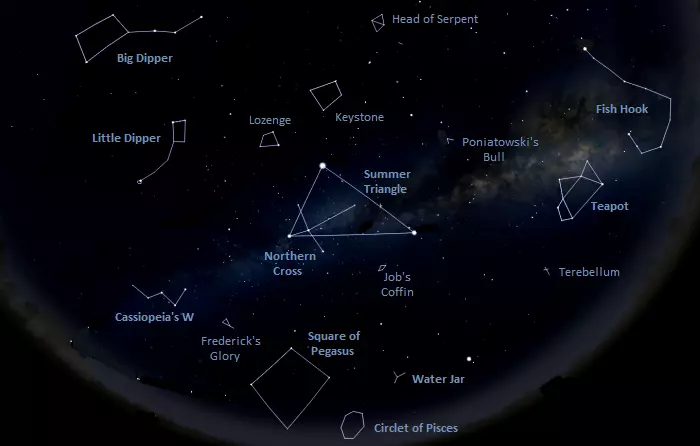
Asterisms in the night sky, image: Stellarium
The Spring Triangle is another example. It is generally taken to be formed by Arcturus, Spica and Regulus, the luminaries of Boötes, Virgo and Leo. However, some observers consider it to be a more equilateral triangle, replacing Regulus with the fainter Denebola at the Lion’s tail. The Kite in Boötes has even more versions. The basic one includes four main stars, while variations with a tether and tail include up to 10 stars. The main pattern of Auriga is a hexagon, but some observers see it as a pentagon, omitting Epsilon Aurigae at the Charioteer’s left elbow. The list of examples goes on.
Some asterisms are not even formed only by stars. The central point of light in Orion’s Sword is the Orion Nebula, the nearest massive star-forming region to the Sun. The False Comet at the Scorpion’s tail consists of both stars and open clusters that, seen together, resemble a comet. The Golden Gate of the Ecliptic, which is often listed as an asterism, consists of two bright open clusters: the Pleiades and the Hyades.
Even though there are no rules when it comes to calling any interesting or useful pattern an asterism, there have been attempts to classify these patterns in terms of their relationship to their host constellation(s). In his 2016 book Uncharted Constellations: Asterisms, Single-Source and Rebrands, John C. Barentine divides them into aliases, sectional, non-sectional and cross-border asterisms.
Alias asterisms are those that give their host constellations alternative names (the Kite in Boötes, the Northern Cross in Cygnus). Sectional asterisms are those created from stars that form a part of the constellation’s main figure (the Gorgon’s Head in Perseus, the Water Jar in Aquarius, Orion’s Belt, Sword and Shield). Non-sectional asterisms are similar, but not identified as related to the main figure (the Teapot in Sagittarius, the Keystone in Hercules, the Sickle in Leo). Cross-border asterisms are formed by stars from different constellations (the Summer Triangle, Winter Hexagon, Egyptian X).
Difference between constellation and asterism
Constellations and asterisms were once the same thing: groups of stars that formed recognizable patterns. However, since the early 20th century, when the constellation boundaries were formally set, the word constellation has come to refer to a specific area of the sky, as clearly defined as a country on map, whereas the word asterism has retained its old meaning. For example, the Big Dipper is an asterism formed by the brightest stars of the constellation Ursa Major, and the Northern Cross is an asterism in the constellation Cygnus.
Constellations and asterisms are often used synonymously, and some languages still do not make a distinction between them. The words themselves have the same origin. Constellation comes from the Latin cōnstellātiō, meaning “set of stars” (from stella, meaning “star”), and asterism is derived from the Greek asterismos (ἀστερισμός), meaning “a group of stars” (from the Greek word for “star,” aster).
The English names of several constellations are also the names of the asterisms that define these constellations. The Southern Cross is an asterism formed by the brightest stars in Crux, but it is also the English name of the constellation Crux. The Northern Crown and the Southern Crown are the English names of Corona Borealis and Corona Australis, but can also refer to the asterisms for which the constellations were named. This is how Sagitta (the Arrow), Triangulum (the Triangle) and Triangulum Australe (the Southern Triangle) got their names as well. However, the difference between the terms “constellation” and “asterism” remains simple: a constellation is an area of the sky and an asterism is a star pattern.
Asterisms examples
Asterisms can be formed by stars of one or more constellations. Several large asterisms formed by stars from different constellation define the seasonal skies in the northern hemisphere. These are:
- the Spring Triangle (Arcturus in Boötes, Spica in Virgo, and Regulus in Leo)
- the Diamond of Virgo (Cor Caroli in Canes Venatici, Arcturus in Boötes, Spica in Virgo, and Denebola in Leo)
- the Summer Triangle (Vega in Lyra, Altair in Aquila, and Deneb in Cygnus)
- the Great Square of Pegasus (Alpheratz in Andromeda and Algenib, Scheat and Markab in Pegasus)
- the Winter Triangle (Betelgeuse in Orion, Sirius in Canis Major, and Procyon in Canis Minor)
- the Winter Hexagon (Rigel in Orion, Aldebaran in Taurus, Capella in Auriga, Pollux in Gemini, Procyon in Canis Minor, and Sirius in Canis Major)
Constellation-based asterisms are often the most recognizable features of their host constellations. The best-known examples include:
- Orion’s Belt in Orion
- the Teapot in Sagittarius
- the Big Dipper in Ursa Major
- the Little Dipper in Ursa Minor
- Cassiopeia’s W
- the Fish Hook in Scorpius
- the Northern Cross in Cygnus
- the Sickle of Leo
- the Southern Cross in Crux
These star patterns can be used to identify bright stars and fainter constellations, as well as find any deep sky objects in the same area. For example, a line drawn through the Orion’s Belt points towards Sirius in one direction and Aldebaran in the other. The arc of the Big Dipper’s handle leads to Arcturus and Spica, while the stars that form the outer part of the Dipper’s bowl point to Polaris. The inner stars of the bowl lead to Regulus in Leo. The Sickle of Leo makes it easy to identify Alphard in Hydra and find several Messier galaxies, while the Teapot in Sagittarius is a guide to the many bright nebulae and clusters in and near Sagittarius.
List of asterisms
The asterisms listed below are grouped by season because seasonal patterns tend to lie in the same areas of the sky. Wherever possible, asterisms in the same constellation are listed consecutively. If the stars forming the asterism belong to the same constellation, the constellation is given in brackets.
The list includes both asterisms visible to the unaided eye and those that make interesting targets for binoculars and small telescopes. It is by no means complete, but it covers most of the larger star patterns that make their host constellations easy to identify and some smaller ones that help observers find bright deep sky objects. Several small, distinctive constellation figures are included, as well as a couple of open clusters with unique shapes.
Spring asterisms
The spring sky offers the best views of the asterisms in the constellation Ursa Major, Boötes, Leo, Virgo, Centaurus, and Crux. The stars of some of these constellations form two large seasonal asterisms: the Spring Triangle and the Diamond of Virgo.
Spring Triangle
Formed by Arcturus, Spica and Regulus, the brightest stars in Boötes, Virgo and Leo, the Spring Triangle is easily found using the stars of the Big Dipper. Arcturus and Spica are the brightest stars on the imaginary curved line extended away from the Dipper’s handle, and Regulus lies on the line drawn from the inner stars of the Dipper’s bowl (Megrez and Phecda). Each of the three stars of the Spring Triangle lies at the base of its own constellation-based asterism: Arcturus in the Kite, Spica in the Y of Virgo, and Regulus in the Sickle.
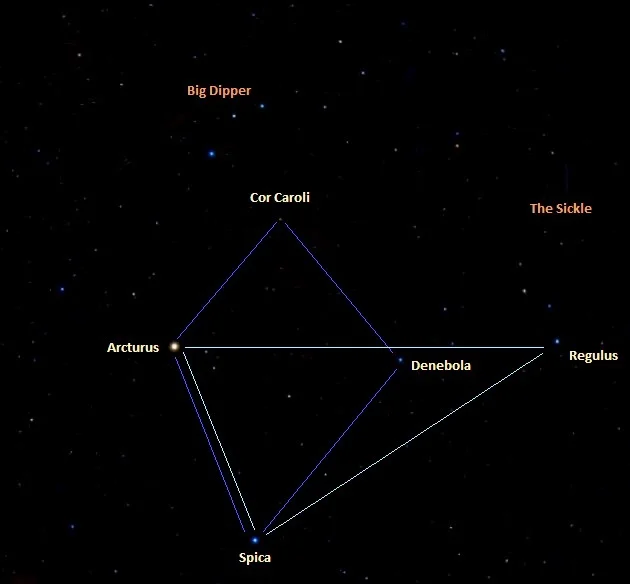
The Spring Triangle and the Great Diamond of Virgo, image: Wikisky
Diamond of Virgo
The Spring Triangle shares two vertices with the Diamond of Virgo. Also known as the Great Diamond, the Diamond of Virgo is formed by Arcturus and Spica with Denebola in Leo and Cor Caroli in Canes Venatici. Cor Caroli is found directly below Alkaid, the star at the tip of the Big Dipper’s handle, and Denebola lies at the Lion’s tail.
The Great Diamond makes an excellent signpost for finding the bright galaxies of the Virgo Cluster, which lie about halfway between Denebola and Vindemiatrix, a relatively bright star near the centre of the Diamond. Denebola and the brighter Regulus can be used to find two bright galaxy groups that lie in the area between them: the Leo I (M96) Group and the Leo Triplet (the M66 Group).
Sickle of Leo (Leo)
Regulus is the brightest star in the Sickle of Leo, a conspicuous asterism that outlines the Lion’s head and mane. The Sickle appears as a backward question mark. Regulus lies at the base and Epsilon, Mu, Zeta, Gamma and Eta Leonis form the semi-circle above it.
The Sickle of Leo can be used to find the bright Beehive Cluster (M44), which appears close to the line connecting Regulus and Pollux in Gemini.
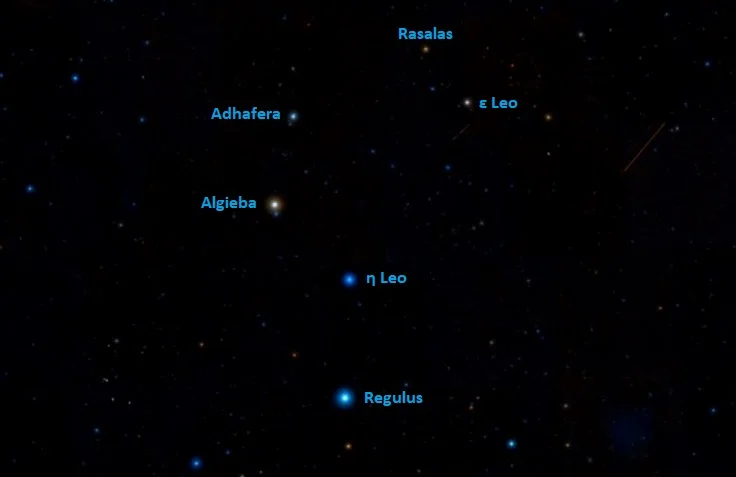
The Sickle of Leo, image: Wikisky
Big Dipper (Ursa Major)
To the north, Ursa Major hosts several asterisms. The best-known of these is the Big Dipper, formed by the seven bright stars that outline the Great Bear’s hindquarters and tail: Alkaid (Eta UMa), Mizar (Zeta UMa), Alioth (Epsilon UMa), Megrez (Delta UMa), Phecda (Gamma UMa), Dubhe (Alpha UMa), and Merak (Beta UMa).
The Big Dipper is known by many other names, among them the Plough, the Saucepan, and the Great Wagon. Its stars are guideposts to all the constellations in this region of the sky: Ursa Minor, Draco, Boötes, Canes Venatici, Leo Minor, Leo, and Lynx. They can also be used to find several bright galaxies in the area. These include the Pinwheel Galaxy (M101), Bode’s Galaxy (M81), the Cigar Galaxy (M82), the Whirlpool Galaxy (M51), and the Sunflower Galaxy (M63).
Ursa Major stars are visible throughout the year to northern observers. Spring is the best time to observe them because they rise in the east in the evening and make their way across the sky as the night progresses. They are also relatively high in the sky in the summer months, but stay closer to the horizon during autumn and winter.
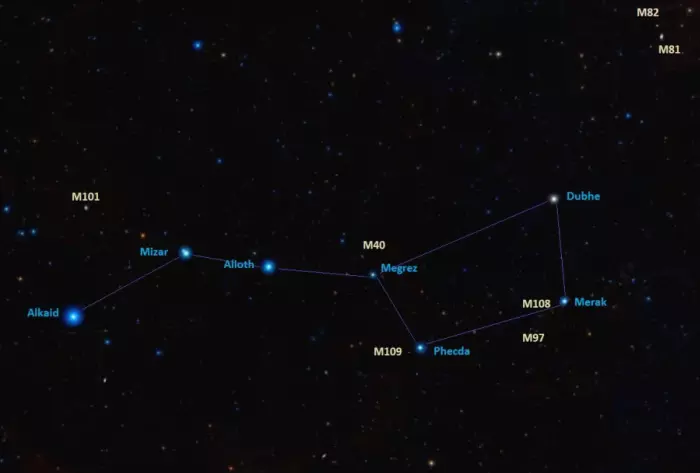
Messier objects near the Big Dipper, image: Wikisky
Three Leaps of the Gazelle (Ursa Major)
In addition to the Big Dipper, Ursa Major hosts several fainter asterisms. The six stars at the feet of the Great Bear are known as the Three Leaps of the Gazelle. Arranged in three pairs, they are: Alula Borealis (Nu UMa) and Alula Australis (Xi UMa), Tania Borealis (Lambda UMa) and Tania Australis (Mu UMa), and Talitha (Iota UMa) and Alkaphrah (Kappa UMa).
The stars’ names come from the Arabic name of the asterism. Alkaphrah is derived from al-qafzah, “the leap.” Alula comes from the phrase Al Ḳafzah al Ūla (“the first spring”), Tania is derived from Al Fiḳrah al Thānia, “the second spring,” and Talitha from Al Fiḳrah al Thalitha, “the third spring.” Borealis and australis are Latin words for “northern” and “southern.”
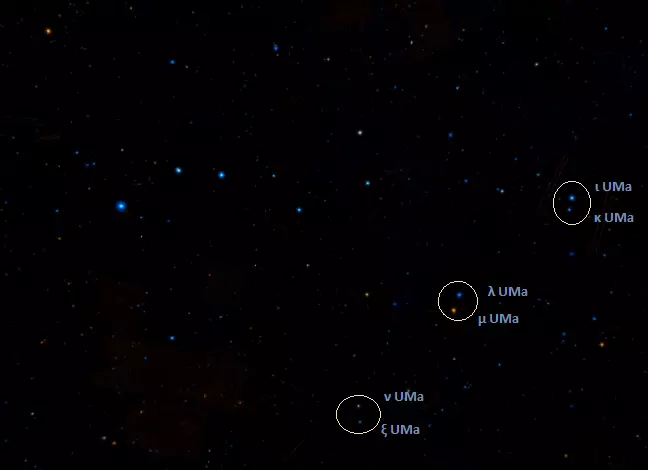
Three Leaps of the Gazelle, image: Wikisky
Horse and Rider (Ursa Major)
Mizar and Alcor form a visual double star in the Big Dipper’s handle. Mizar is the middle of the three stars in the handle. It has an apparent magnitude of 2.04, while the fainter Alcor shines at magnitude 3.99. The two stars are separated by 12 arcminutes and were once used as a test of good eyesight. The pair is known as Horse and Rider or Jack on the Middle Horse. The brighter Mizar is the horse and Alcor is the rider.
Broken Engagement Ring (Ursa Major)
Merak, the southern of the two outer stars of the Big Dipper’s bowl, lies close to the Broken Engagement Ring, a semi-circle of stars with a magnitude 7.4 star appearing as the diamond. The asterism is invisible to the unaided eye but stretches 15 arcminutes across and can be observed in small telescopes. It lies just over a degree west of Merak.
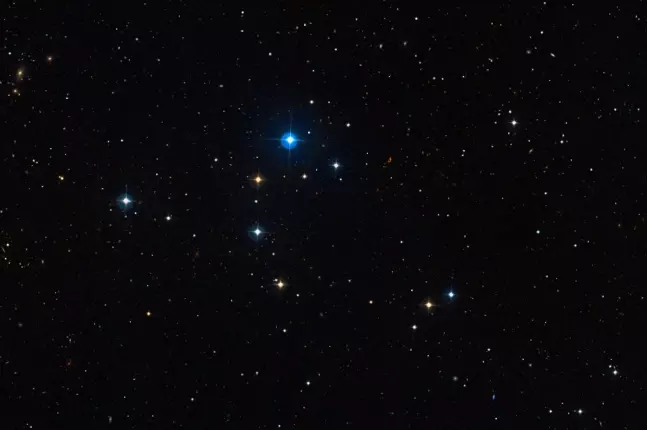
Broken Engagement Ring, image: Wikisky
Eiffel Tower (Ursa Major)
The Eiffel Tower (Ferrero 6) was named by the French amateur astronomer Laurent Ferrero, who keeps a catalogue of his discoveries at Splendeurs du ciel profond. The celestial landmark spans 28 arcminutes and forms a triangle with Mizar and Alioth in the Big Dipper’s handle.
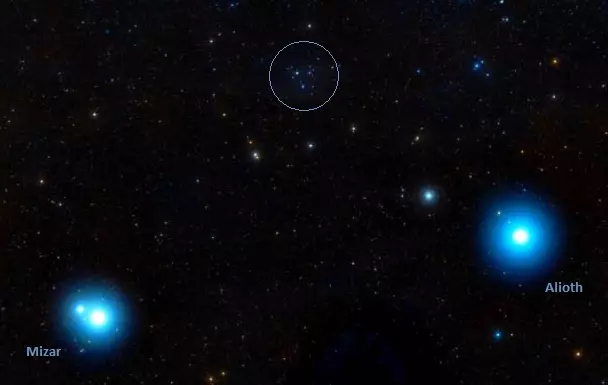
The Eiffel Tower asterism, image: Wikisky
Messier 40 (Ursa Major)
Messier 40 (Winnecke 40) is another visual double, but unlike Mizar and Alcor, it consists of two stars that are not physically related. The pair was mistakenly catalogued by Charles Messier while searching for a nebula. The two stars are now known to merely appear in the same line of sight. They appear 1.5 degrees northeast of Megrez, the star in the Big Dipper’s bowl closest to the handle.
Pointer Stars (Ursa Major)
Merak and Dubhe, the outer stars of the Big Dipper’s bowl, are known as the Pointer Stars because they point toward Polaris, the North Star. Polaris is the nearest visible star to the north celestial pole and part of the Little Dipper, a smaller and fainter asterism located north of its larger counterpart. Polaris marks the tip of the Little Dipper’s handle and of the Little Bear’s tail.
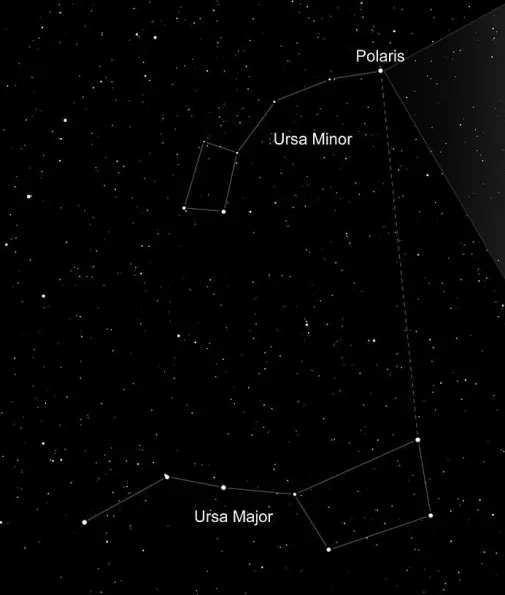
Location of Polaris and the Little Dipper, image: Hubblesite. Credit: NASA, ESA, N. Evans (Harvard-Smithsonian CfA), and H. Bond (STScI)
Little Dipper (Ursa Minor)
Like the Big Dipper, the Little Dipper stays visible year-round for northern observers. It is formed by seven relatively bright stars: Polaris (Alpha UMi), Yildun (Delta UMi), Epsilon UMi, Eta UMi, Zeta UMi, Kochab (Beta UMi), and Pherkad (Gamma UMi). Polaris, Kochab and Pherkad are easy to spot, but the middle four stars require clear, dark skies to be seen. Polaris always stays in the same place in the sky while other stars appear to rotate around it.
Polaris is used in celestial navigation as a marker of true north. As a supergiant, it is an exceptionally luminous star, but it lies between 323 and 433 light years away and barely makes the list of the 50 brightest stars. With an apparent magnitude of 1.98, it is the 48th brightest star in the sky.
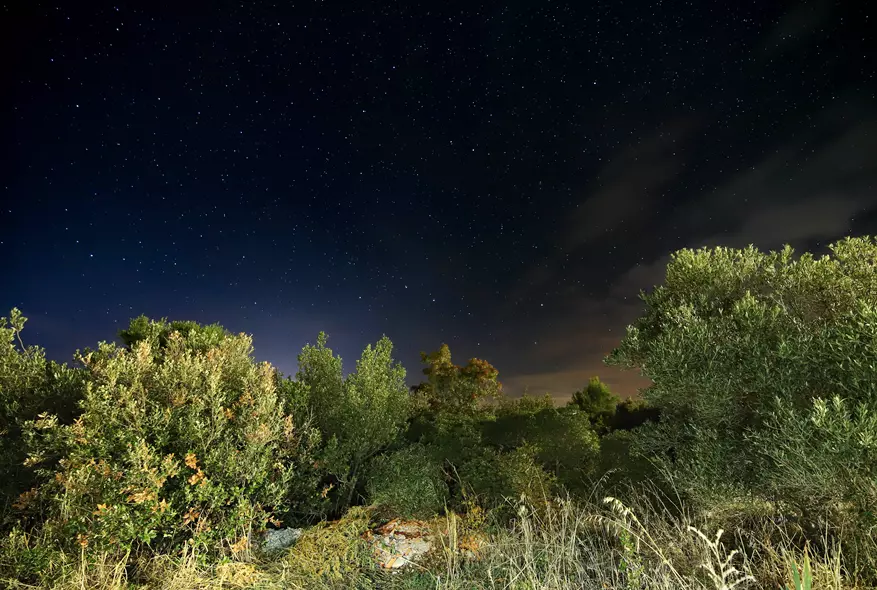
Big and Little Dippers, image: Constellation Guide
Guardians of the Pole (Ursa Minor)
Kochab and Pherkad are known as the Guardians of the Pole. The two outer stars of the Little Dipper’s bowl are the nearest bright stars to Polaris and appear to be continually circling around it. In fact, Kochab is one of the stars that mark true north over the course of Earth’s precession cycle. Around the year 2467 BCE, the north celestial pole lay between Kochab and Mizar and, around 1100 BCE, Kochab came within 7 degrees of the pole. Kochab and Pherkad were twin pole stars until around the year 300 CE, when the pole gradually shifted toward Polaris.
In less-than-ideal conditions, when the middle stars of the Little Dipper are difficult to see, the Guardians of the Pole can be identified as the two relatively bright stars that are roughly parallel to Mizar and Alioth, the central and right star of the Big Dipper’s handle. Only the fainter stars of Draco’s tail lie in the area between.
The Engagement Ring (Ursa Minor, Cepheus)
Polaris is the diamond in the Engagement Ring, a telescopic asterism appearing as a circle of 9th magnitude and brighter stars less than a degree across. Polaris is the brightest star in the circle and the fainter stars lie on the border with Cepheus.
The Engagement Ring (or Diamond Ring) can be used to find the north celestial pole, which lies on the opposite side of the ring. The separation between Polaris and the pole is just a little less than the diameter of the ring.
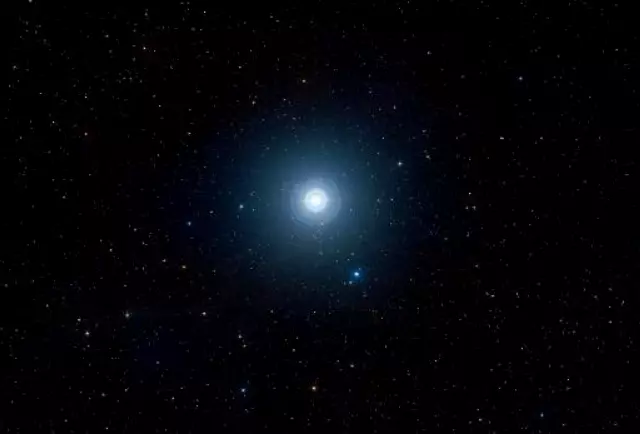
Polaris and the Engagement Ring, image: Wikisky
The Kite (Boötes)
The Kite is the most recognizable feature of Boötes, the Herdsman. Located between the handle of the Big Dipper and the crown-like pattern of Corona Borealis, the Kite is a little fainter than these two, but easily discernible on a clear night.
The asterism has Arcturus, the brightest star in the northern celestial hemisphere, at the base and is also formed by Izar (Epsilon Boötis), Princeps (Delta Boötis), Nekkar (Beta Boötis), Seginus (Gamma Boötis), and Rho Boötis. Some observers exclude Izar and Rho Boötis from the pattern, while others add Zeta, Eta, Tau, and Upsilon Boötis to give the celestial Kite a tether and tail.
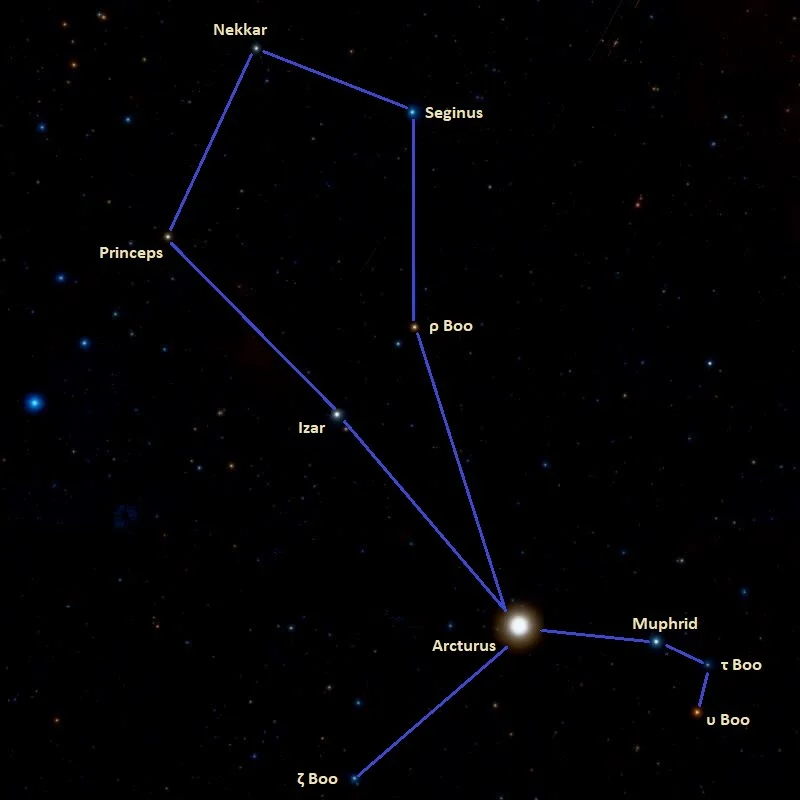
Kite stars, image: Wikisky
Napoleon’s Hat (Boötes)
Located only 40 arcminutes south-southwest of Arcturus, Napoleon’s Hat (Picot 1) is formed by seven stars with apparent magnitudes from 9.4 to 10.7. The stars outline the brim of the hat, which spans about 20 arcminutes. The asterism was named by the French amateur astronomer Fulbert Picot.
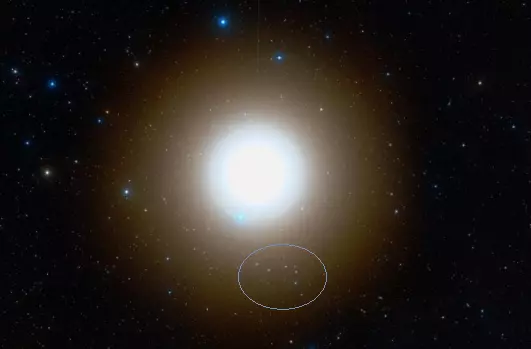
Arcturus and Napoleon’s Hat, image: Wikisky
The Y of Virgo (Virgo)
The Y of Virgo is the most visible part of Virgo. The asterism lies in the western part of the constellation. Spica, Virgo’s brightest star, forms the Y with Porrima (Gamma Vir), Minelauva (Delta Vir), Vindemiatrix (Epsilon Vir), Zaniah (Eta Vir), and Zavijava (Beta Vir). The Virgo Cluster of galaxies appears just above the asterism, halfway between Vindemiatrix and Denebola.
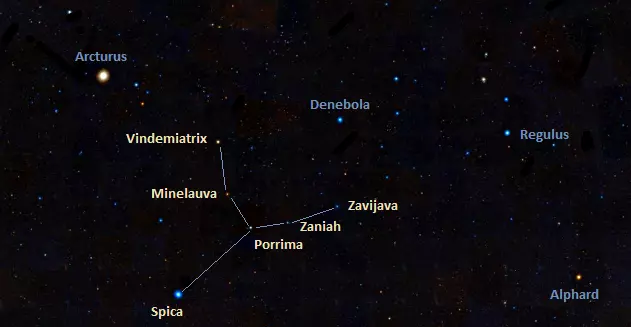
The Y of Virgo and the Sickle of Leo, image Wikisky
Spica’s Spanker (the Sail, Corvus)
Spica’s Spanker is a relatively bright pattern near Spica formed by the brightest stars of Corvus: Gienah (Gamma Corvi), Algorab (Delta Corvi), Kraz (Beta Corvi), and Minkar (Epsilon Corvi). Gienah and Algorab point the way to Spica. The asterism is also known as the Sail.
Spica’s Spanker is used to find the famous Sombrero Galaxy (Messier 104) in Virgo and the interacting pair known as the Antennae Galaxies (NGC 4038 and NGC 4039) in Corvus.
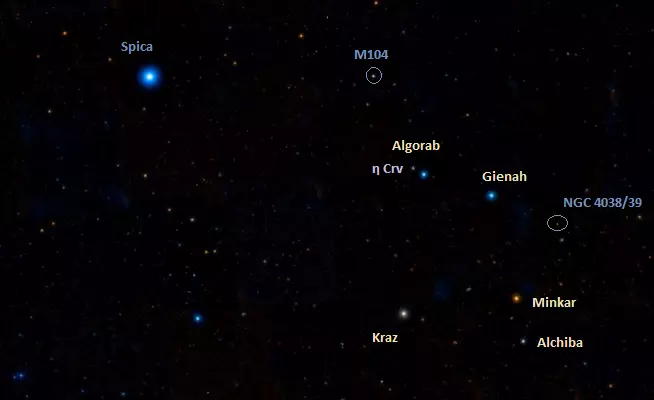
Spica’s Spanker and the Throne in Corvus, image: Wikisky
The Throne (Corvus)
The pattern formed by the stars of the Sail with Eta Corvi (the fainter star near Algorab) and Alchiba (Alpha Corvi) is sometimes called the Throne.
Jaws (Virgo)
The Sombrero Galaxy lies next to a telescopic asterism that was named Jaws by the author Philip S. Harrington in his book The Deep Sky: An Introduction. The asterism spans about 27 arcminutes and is found northwest of the Sombrero.
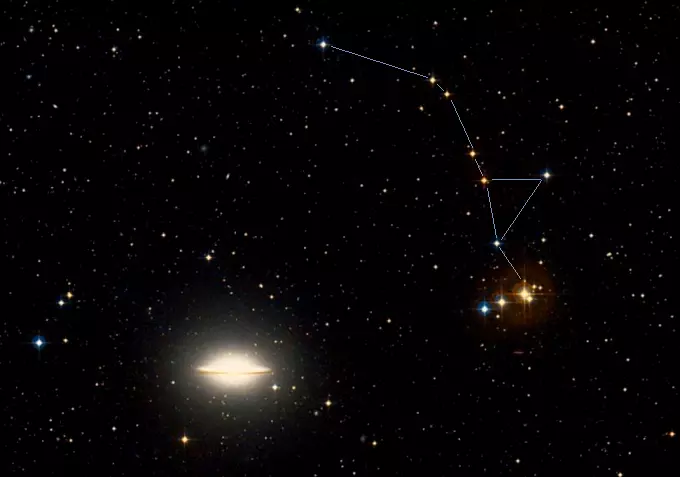
Jaws and the Sombrero Galaxy, image: Wikisky
Stargate (Corvus)
Another relatively new asterism lies southwest of the Sombrero Galaxy and the Jaws pattern: Stargate. Formed by six stars arranged in two triangles, Stargate is a nod to the popular television series Buck Rogers in the 25th Century. Like Jaws and the Sombrero, Stargate can be observed in amateur telescopes.
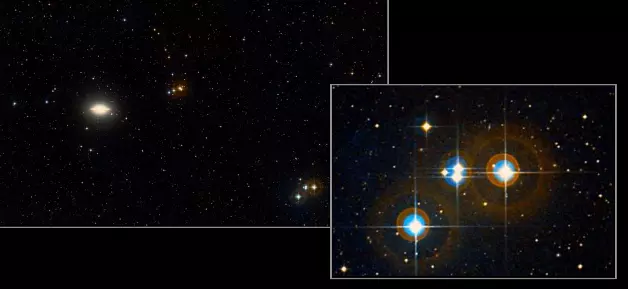
Stargate asterism, image: Wikisky
Head of Hydra (Hydra)
The Head of Hydra is a relatively faint asterism located roughly halfway between Regulus in Leo and Procyon in Canis Minor. It is formed by five stars: Ashlesha (Epsilon Hya), Delta Hydrae, Eta Hydrae, Rho Hydrae, and Minchir (Sigma Hya). The brightest of these, Ashlesha, has an apparent magnitude of 3.38 and the faintest, Minchir, 4.48. Some observers also add Zeta Hydrae to the asterism. Hydra’s Head requires clear, dark skies to be seen.
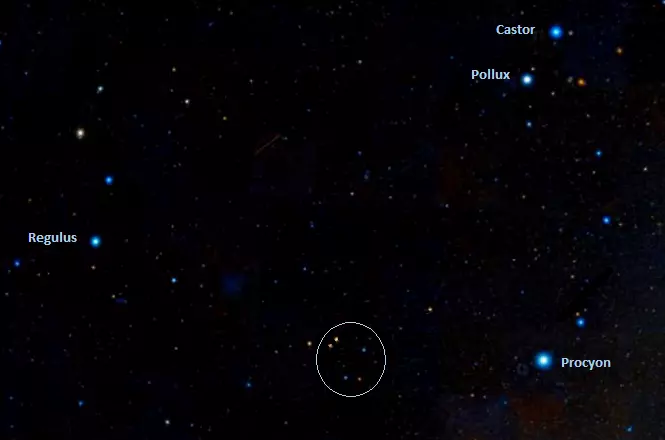
The Head of Hydra, image: Wikisky
Southern Cross (Crux)
Two prominent asterisms in the far southern sky are visible to northern observers living south of the latitude 25° N during the spring months: the Southern Cross and the Southern Pointers.
The Southern Cross is formed by the brightest stars in the constellation Crux: Acrux (Alpha Crucis), Mimosa (Beta Crucis), Gacrux (Gamma Crucis), Imai (Delta Cruis), and Ginan (Epsilon Crucis). Ginan, the faintest of the five stars, is not always included in the depictions of the asterism.
Like its southern neighbours for which it is sometimes mistaken – the Diamond Cross and the False Cross – the Southern Cross does not really look like a cross. It is more diamond shaped. It appears brighter and smaller than the other two asterisms, with two first-magnitude stars (Acrux and Mimosa) at its vertices.
The Southern Cross is used to find the Jewel Box Cluster (Kappa Crucis Cluster, NGC 4755), a bright, large open cluster a degree southeast of Mimosa, and the Coalsack Nebula, one of the most conspicuous dark nebulae in the sky. The Coalsack stretches from the area between Acrux and Mimosa into the neighbouring constellations Centaurus and Musca. In Aboriginal astronomy, it forms the head of the Emu in the Sky.
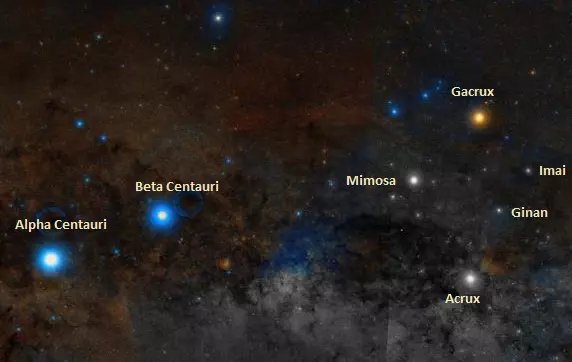
Alpha and Beta Centauri and the Southern Cross, image: Wikisky
Southern Pointers (Centaurus)
The easiest way to identify the Southern Cross is using the Southern Pointers, Alpha and Beta Centauri. The luminaries of Centaurus are the third and 11th brightest stars in the sky. They point toward Gacrux, the star at the top of the Southern Cross.
Alpha Centauri is the nearest star system to the Sun, located only 4.37 light years away. It hosts Proxima Centauri, the nearest individual star to our solar system. Hadar (Beta Centauri) is a more evolved giant star that lies at a greater distance, about 390 light years away. As a nearby star system, Alpha Centauri has a high proper motion, which is slowly taking it toward Hadar. In the year 6200 CE, the two stars will form a conjunction, appearing as an exceptionally bright visual double.
The Frying Pan (Chamaeleon)
The Frying Pan is an asterism that gives the southern constellation Chamaeleon its alternative name in Australia. It is formed by the constellation’s brightest stars: Alpha, Gamma, Beta, Theta, Delta and Epsilon Chamaeleontis. The stars have apparent magnitudes from 4.05 to 4.88, making the asterism challenging to see from light-polluted areas.
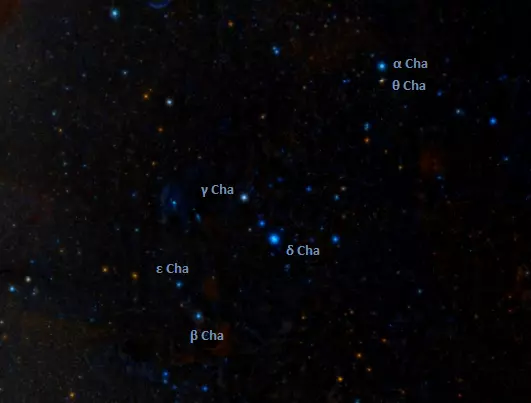
The Frying Pan, image: Wikisky
Summer asterisms
Summer is the best time of year to observe asterisms in the constellations Aquila, Cygnus, Lyra, Delphinus, Draco, Hercules, Ophiuchus, Sagittarius, Scorpius, and Vulpecula. The summer sky in the northern hemisphere is dominated by a large asterism known as the Summer Triangle.
Summer Triangle
The Summer Triangle is a large summer asterism formed by Vega, Altair and Deneb, the brightest stars in the constellations Lyra, Aquila and Cygnus. With three first-magnitude stars at its vertices, the pattern is easily visible high overhead in the summer evenings.
The Summer Triangle connects three smaller yet distinctive asterisms in Lyra, Aquila and Cygnus – the Harp, the Shaft of Aquila, and the Northern Cross. It also helps find several smaller constellations – Delphinus, Sagitta, and Vulpecula – located in this area of the sky.
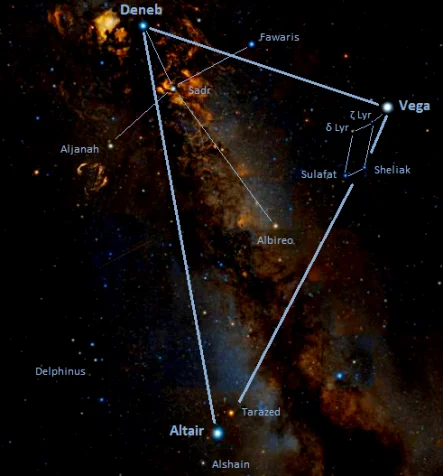
The Summer Triangle, the Northern Cross, Lyra and the Shaft of Aquila, image: Wikisky
The Harp (Lyra)
Representing the lyre of Orpheus in Greek mythology, the main asterism of Lyra is formed by six stars: Vega (Alpha Lyrae), Epsilon Lyrae, Zeta Lyrae, Delta Lyrae, Sheliak (Beta Lyrae), and Sulafat (Gamma Lyrae). The brightest of these, Vega, is the fifth brightest star in the sky. The other five stars are considerably fainter and may be challenging to find from heavily light-polluted areas. Sulafat, Lyra’s second brightest star, shines at magnitude 3.26.
Beta and Gamma Lyrae are commonly used to find the famous Ring Nebula (Messier 57), which lies halfway between the two stars. The bright globular cluster Messier 56 is found between Sulafat and Albireo in Cygnus, and extending the line from Sulafat through Albireo leads to the Dumbbell Nebula (Messier 27) in the constellation Vulpecula.
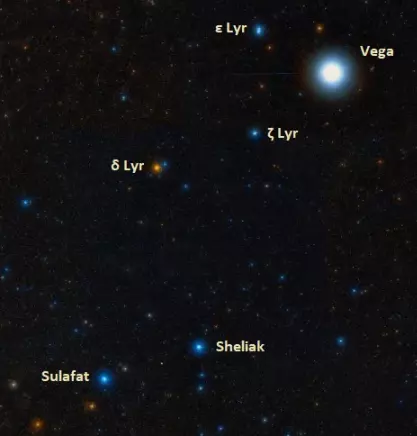
Lyra stars, image: Wikisky
The Shaft of Aquila (Aquila)
Altair (Alpha Aquilae), the luminary of Aquila, is the 12th brightest star in the sky. It is very easy to identify because it is flanked by two other relatively bright stars, Alshain and Tarazed (Beta and Gamma Aquilae). The three stars form a straight line known as the Shaft of Aquila or Family of Aquila. They mark the head and neck of the celestial Eagle.
Northern Cross (Cygnus)
The region of the Northern Cross, the large, conspicuous asterism that dominates the Swan constellation, is one of the most popular targets for backyard telescopes. Cygnus lies in a rich Milky Way field and hosts many well-known nebulae and clusters, most of which are easily found using the stars of the Northern Cross.
Unlike the Southern Cross, the Northern Cross really looks like a cross. The supergiant Deneb (Alpha Cygni), the 19th brightest star in the sky and by far the most distant first-magnitude star, sits at the top, next to the North America Nebula (NGC 7000) and the Pelican Nebula (IC 5070). Sadr (Gamma Cygni), another supergiant, marks the centre and appears surrounded by a large diffuse nebula known as the Sadr Region (IC 1318). Aljanah (Epsilon Cygni) and Fawaris (Delta Cygni) mark the crossbeam, and Albireo (Beta Cygni), one of the finest contrasting visual doubles, lies at the base.
Aljanah is the go-to star to find the Veil Nebula, a vast supernova remnant 65 light years across, while Fawaris can be used to find another summer asterism: the Head of Draco.
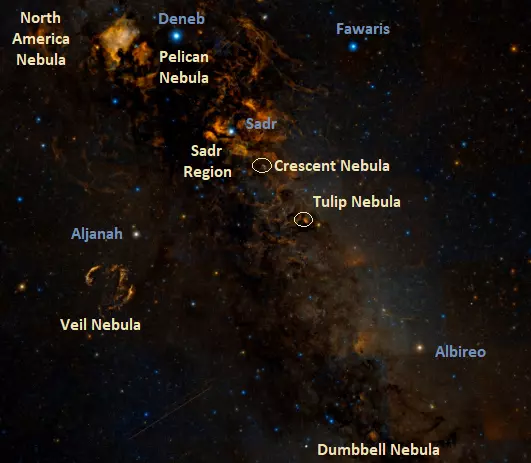
Nebulae in the region of the Northern Cross in Cygnus, image: Wikisky
The Head of Draco (Draco)
The four-star pattern outlining the head of the Dragon can be found by extending the line of the beam of the Northern Cross, from Sadr through Fawaris, away from the Cross asterism.
The Dragon’s Head is formed by Eltanin (Gamma Draconis), Rastaban (Beta Draconis), Grumium (Xi Draconis), and Kuma (Nu Draconis). Eltanin and Rastaban mark the Dragon’s eyes.
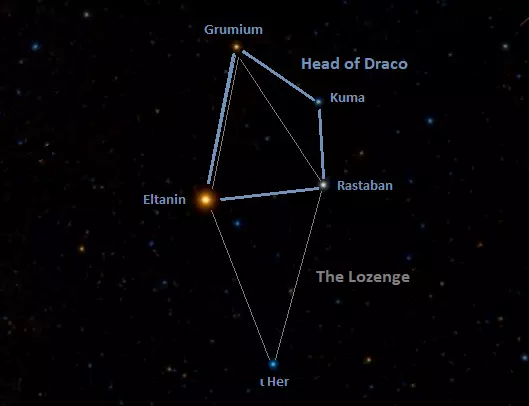
The Head of Draco and the Lozenge, image: Wikisky
The Lozenge (Draco, Hercules)
The Lozenge shares three stars with the Head of Draco – Eltanin, Grumium and Rastaban – but the fourth vertex of the diamond-shaped pattern is at Iota Herculis in the neighbouring constellation Hercules. Some observers see the Lozenge and the Head of Draco as identical, formed by Beta, Gamma, Xi, and Nu Draconis.
The Ring of the Nibelung (Draco)
The Ring of the Nibelung (Ferrero 27) is a ring-like telescopic asterism about 1.7 arcminutes across. It was named by the French amateur astronomer Laurent Ferrero, who discovered it in 2005. The asterism is formed by six stars with apparent magnitudes from 11.7 to 15.0.
Named after the Norse mythical magic ring forged by the Nibelung, the asterism can be found in the relatively faint region of the sky between the Head of Draco and the handle of the Big Dipper. It lies west of Athebyne (Eta Draconis), 47 arcminutes east-northeast of the galaxy NGC 6015 and 1.3 degrees east of the magnitude 5.19 star HD 141653.
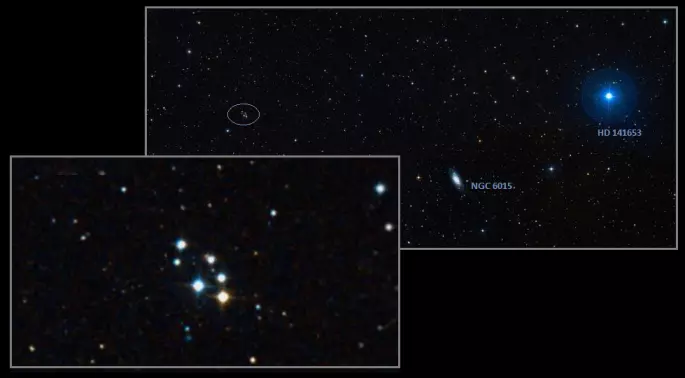
The Ring of the Nibelung, image: Wikisky
The Coathanger (Vulpecula)
The Coathanger is formed by a group of unrelated stars in the constellation Vulpecula, near the border with Sagitta. The pattern was once believed to be an open cluster and is also known as Al Sufi’s Cluster or Brocchi’s Cluster. It is catalogued as Collinder 399 in Swedish astronomer Per Collinder’s catalogue of open clusters. However, the stars are now known to merely lie in the same line of sight. The asterism was first documented by the Persian astronomer Al Sufi in his Book of Fixed Stars (964 CE).
The Coathanger is found south of Albireo, the star at the base of the Northern Cross, near the pattern of the celestial Arrow.
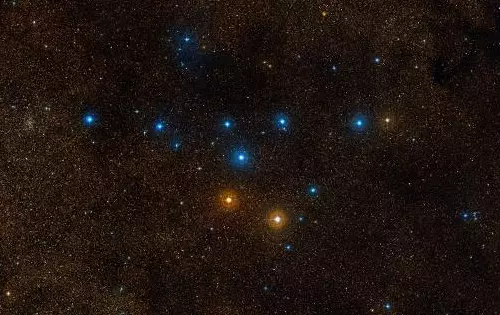
The Coathanger (Brocchi’s Cluster), image: Wikisky
The Arrow (Sagitta)
The main asterism of Sagitta is formed by Alpha, Beta, Gamma and Delta Sagittae. Representing the arrow that Heracles used to do away with Zeus’ eagle (Aquila) that was gnawing Prometheus’ liver, the asterism has been known as the Arrow since the ancient Greeks. It gives the name to its host constellation and is its most recognizable part.
Job’s Coffin (Delphinus)
Job’s Coffin is formed by four relatively bright stars in Delphinus: Rotanev (Beta Delphini), Sualocin (Alpha Delphini), Gamma and Delta Delphini. The two unusual star names – Rotanev and Sualocin – come from the Latinized name of Italian astronomer Niccolò Cacciatore – Nicolaus Venator – written in reverse.
Together with the nearby Aldulfin (Epsilon Delphini), the stars of Job’s Coffin form the distinctive pattern of the celestial dolphin. The asterism lies near the Shaft of Aquila, in the direction of the Square of Pegasus. It can be used to find the Great Pegasus Cluster (Messier 15), which lies between Enif, the brightest star in Pegasus, and Gamma Delphini.
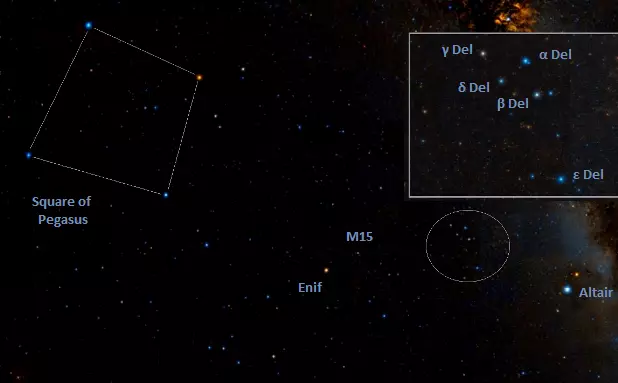
Job’s Coffin, image: Wikisky
The Keystone (Hercules)
The Keystone is a trapezoidal asterism located in the constellation Hercules. It is formed by Pi, Eta, Zeta and Epsilon Herculis. It lies between Vega and Arcturus, just next to the semi-circle of stars that outline the Northern Crown (Corona Borealis).
The asterism forms the torso of Hercules and is commonly used to find the Hercules Globular Cluster (Messier 13), one of the brightest and easiest telescope targets for amateur astronomers.
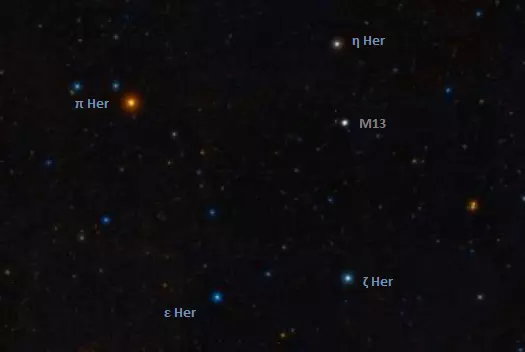
The Keystone, image: Wikisky
Crown of Ariadne (the Northern Crown, Corona Borealis)
Like Sagitta, the constellation Corona Borealis was named directly for its defining pattern. Representing the crown that Ariadne wore at her wedding with Theseus, the main asterism of Corona Borealis is formed by six 4th magnitude stars and the bright Alphecca (Alpha CrB, mag. 2.23). Alphecca marks the jewel in the crown and was traditionally also known as Gemma. The other six stars that form Ariadne’s Crown are Theta, Beta, Gamma, Delta, Epsilon and Iota Coronae Borealis.
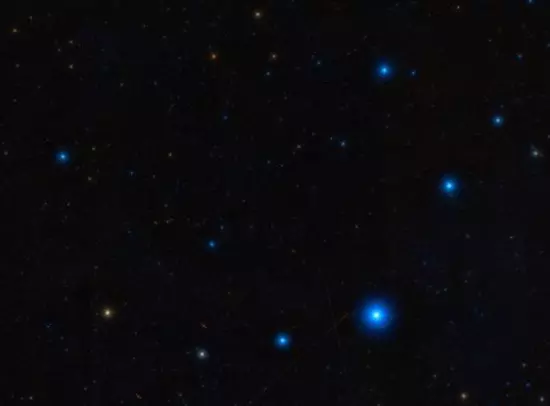
The Crown of Ariadne (Northern Crown), image: Wikisky
Serpent’s Head (Serpens)
The head of the celestial Serpent is formed by the stars Beta, Gamma, Kappa, and Iota Serpentis. The asterism lies in Serpens Caput, west of Ophiuchus and east of Arcturus. It can be found south of the semi-circle of stars that outline the Northern Crown and north of Unukalhai, the brightest star in Serpens.
The brightest star in the Serpent’s Head is Beta Serpentis with an apparent magnitude of 3.65. Some observers exclude the faintest star, Iota (mag. 4.51), from the asterism while others exclude the red giant Kappa Serpentis. The constellation map drawn by the International Astronomical Union (IAU) includes all four stars as part of the head.
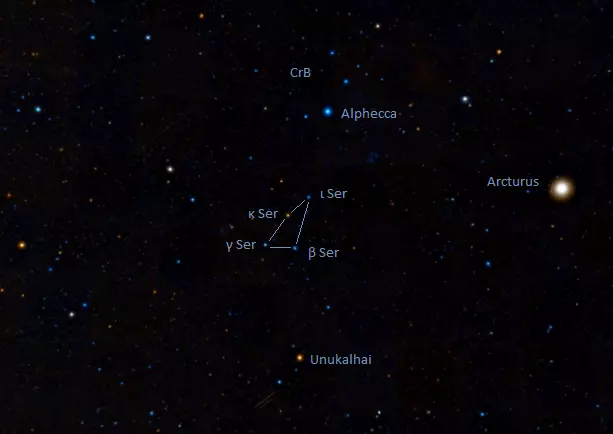
The Serpent’s Head, image: Wikisky
The Teapot (Sagittarius)
The Teapot in Sagittarius is one of the most familiar features of the southern sky. Northern observers can catch it above the southern horizon in the summer evenings. On a clear night, the Milky Way appears as steam coming from the spout.
The Teapot is formed by the eight brightest stars in Sagittarius: Kaus Australis (Epsilon Sagittarii), Kaus Media (Delta Sagittarii), Kaus Borealis (Lambda Sagittarii), Alnasl (Gamma Sagittarii), Ascella (Zeta Sagittarii), Phi Sagittarii, Nunki (Sigma Sagittarii) and Tau Sagittarii. Kaus Borealis, Kaus Media and Kaus Australis mark the Archer’s bow and Alnasl is the arrowhead pointed at Antares, the heart of the Scorpion.
The Teapot lies in the direction of the Milky Way centre, in a region that hosts some of the best-known nebulae in the sky, including the Omega Nebula (Messier 17), Trifid Nebula (Messier 20), and Lagoon Nebula (Messier 8). These nebulae and other deep sky objects in the area can be found using the Teapot stars.
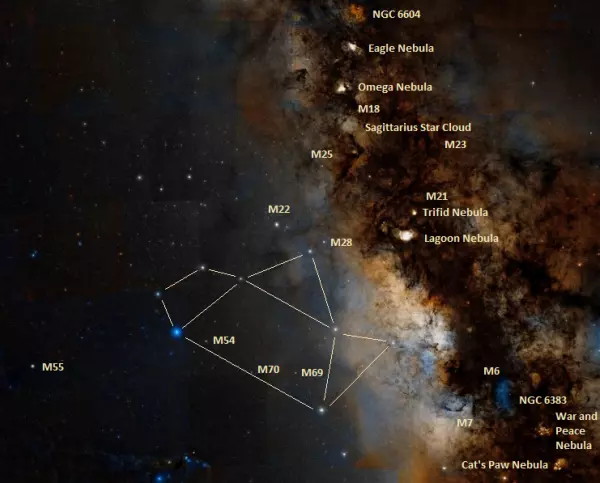
Deep sky objects near the Teapot, image: Wikisky
The Teaspoon (Sagittarius)
The Teaspoon is an asterism formed by Rho1 Sagittarii, 43 Sagittarii (d Sgr), Albaldah (Pi Sagittarii), Omicron Sagittarii, Xi1 and Xi2 Sagittarii. The stars form a curved pattern that appears northeast of the larger and brighter Teapot. Some observers also include Ainalrami (Nu1 Sagittarii) in the asterism.
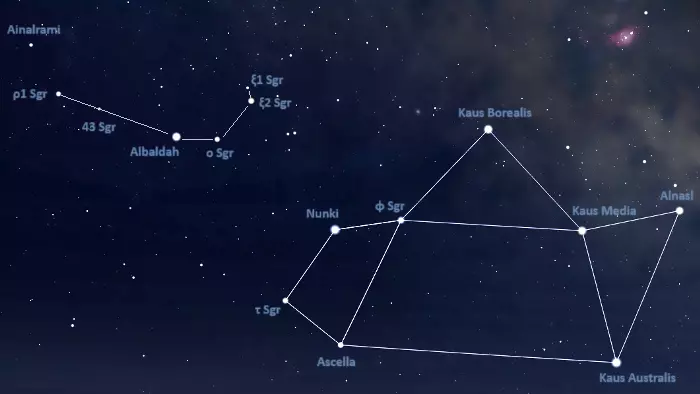
The Teaspoon and the Teapot, image: Stellarium
The Milk Dipper (Sagittarius)
Five stars of the Teapot form a smaller asterism known as the Milk Dipper (or Little Milk Dipper). These are the eastern stars of the Teapot: Nunki, Tau Sagittarii, Phi Sagittarii, Ascella, and Kaus Borealis. Kaus Borealis marks the handle of the Dipper as well as the northern tip of the Archer’s bow.
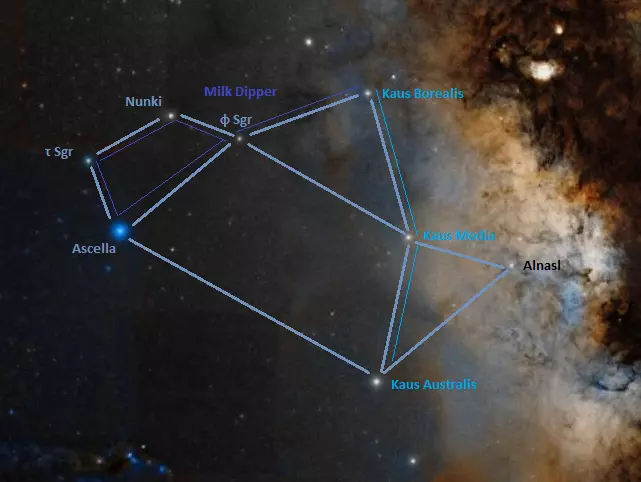
The Teapot and the Little Milk Dipper, image: Wikisky
The Terebellum (Sagittarius)
The Terebellum is a smaller, fainter asterism in Sagittarius, located near the border with Capricornus. It is formed by Omega Sagittarii with 60, 62 and 59 Sagittarii. Omega, the northernmost of the four stars, is formally named Terebellum. The brightest star in the asterism is the variable red giant 62 Sagittarii at the southwest corner, with an apparent magnitude that varies from 4.45 to 4.64.
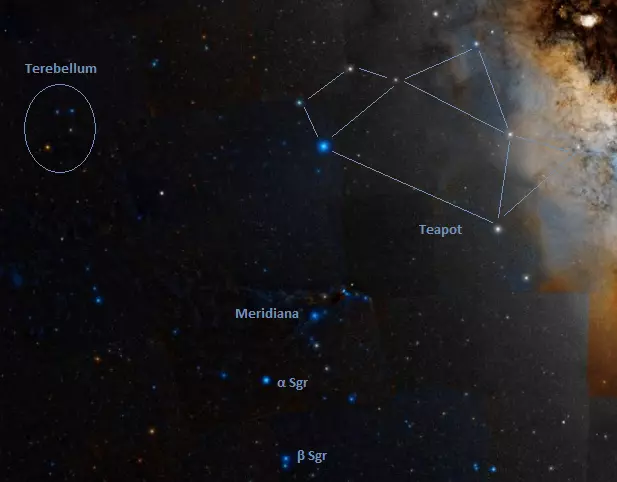
The Terebellum, the Teapot and the Southern Crown, image: Wikisky
Southern Crown (Corona Australis)
Like Sagitta and Corona Borealis, Corona Australis is named after its main asterism. The Southern Crown is fainter than its northern counterpart but distinctive nonetheless. Its brightest star, the magnitude 4.1 Meridiana (Alpha Coronae Australis), is the jewel in the crown. It was traditionally known as Alphekka (or Alphecca) Meridiana, from the Arabic nayyir al-fakka, meaning “the bright one of the broken (ring).” When the International Astronomical Union (IAU) set out to standardize formal names for stars, the name Alphecca went to the luminary of Corona Borealis, leaving Alpha CrA with Meridiana, meaning “south.”
The Southern Crown is located between the southern tip of the Archer’s bow (Kaus Australis) and the fainter Alpha and Beta Sagittarii, the stars marking the Archer’s knee and Achilles tendon.
The Fish Hook (Scorpius)
The Fish Hook is the asterism that makes the constellation Scorpius easily identifiable. Outlined by a curving line of stars from Antares at the Scorpion’s heart to Shaula and Lesath at the stinger, the Fish Hook lies between the Teapot and the Scorpion’s claws.
The asterism is formed by Antares (Alpha Scorpii), Paikauhale (Tau Scorpii), Larawag (Epsilon Scorpii), Mu1 and Mu2 Scorpii (Xamidimura and Pipirima), Zeta1 and Zeta2 Scorpii, Eta Scorpii, Sargas (Theta Scorpii), Iota Scorpii, Girtab (Kappa Scorpii), Shaula (Lambda Scorpii), and Lesath (Upsilon Scorpii).
Antares is a guide to two bright globular clusters: Messier 4 and Messier 80. Messier 4 lies only 1.3 degrees west of the star and Messier 80 is found halfway between Antares and Acrab (Beta Scorpii), the northernmost star of the Scorpion’s claws.
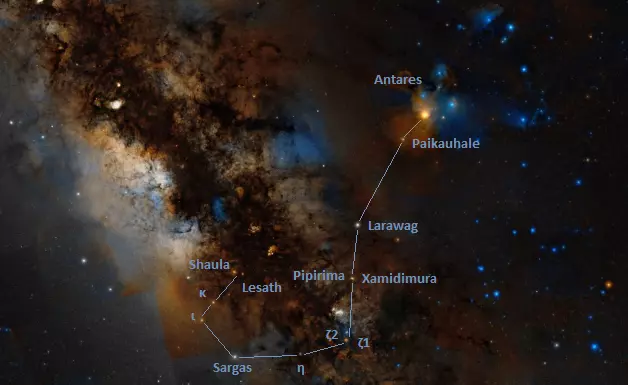
The Fish Hook in Scorpius, image: Wikisky
The Stinger (Scorpius)
Shaula and Lesath mark the Scorpion’s stinger. The second and eighth brightest stars in Scorpius are found in the eastern part of the constellation. They are well-known to stargazers because they can be used to find two exceptionally bright open clusters: the Butterfly Cluster (Messier 6) and Ptolemy Cluster (Messier 7). The clusters lie in the area between the Stinger and the Teapot. Two large nebulae can also be found north and a little west of the stars: the Lobster Nebula (NGC 6357) and Cat’s Paw Nebula (NGC 6334).
False Comet (Scorpius)
The False Comet is one of the more unusual asterisms in that it is not formed by single points of light alone. Located in the area between the contrasting pair Zeta1 and Zeta2 Scorpii and the star systems Mu1 and Mu2 Scorpii, the asterism comprises Zeta Scorpii and several open clusters. The brightest of these, NGC 6231, is popularly known as the Northern Jewel Box because of its similarity to the Jewel Box Cluster (NGC 4755) in Crux. It is one of the brightest open clusters in the sky.
NGC 6231 lies about half a degree north of Zeta Scorpii, which marks the head of the comet. Several fainter clusters populate the area about halfway to Mu Scorpii: Collinder 316 (mag. 3.4), Trumpler 24 (mag. 8.6), and NGC 6242 (mag. 6.4). The Prawn Nebula (IC 4628, mag. 7.31), a large emission nebula, forms part of the comet’s tail, and NGC 6242 marks the end of the tail. The nearby blue stars of the Scorpius OB1 association help give the area a comet-like appearance.
The False Comet was named by the British astronomer John Herschel in the 1830s, during his stay in South Africa. The southernmost star of the asterism, Zeta Scorpii, never rises high above the horizon for observers in mid-northern latitudes, but it is theoretically visible south of the latitude 47° N.
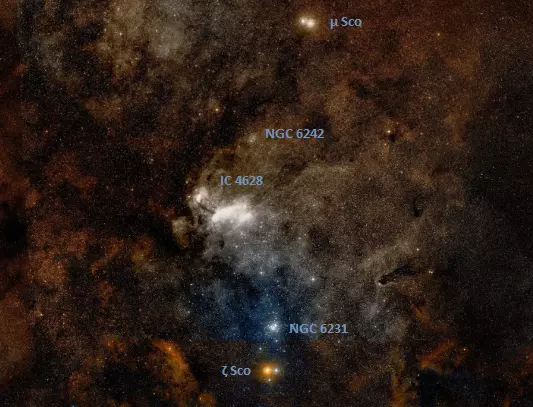
The False Comet, image: Wikisky
Bull of Poniatowski (Ophiuchus)
The Bull of Poniatowski is an asterism located in the northeast part of Ophiuchus, east of Cebalrai (Beta Ophiuchi) and Gamma Ophiuchi. The asterism is all that is left of the obsolete constellation of the same name. It bears a resemblance to the V-shaped Hyades cluster, which outlines the face of the celestial Bull. It is formed by the faint stars 66, 67, 68, 70, and 73 Ophiuchi.
The constellation Taurus Poniatovii was created in 1777 by the Polish-Lithuanian astronomer Marcin Odlanicki Poczobutt to honour Stanislaus Poniatowski, King of Poland (1764 – 1795). The brightest star in the constellation was 72 Ophiuchi, which lies north of the asterism.
The Bull of Poniatowski can be used to locate Barnard’s Star, the fourth nearest individual star to Earth (after the three components of the Alpha Centauri system). The red dwarf lies only 5.9629 light years away and appears near 66 Ophiuchi. With an apparent magnitude of 9.5, it can only be seen in a telescope.
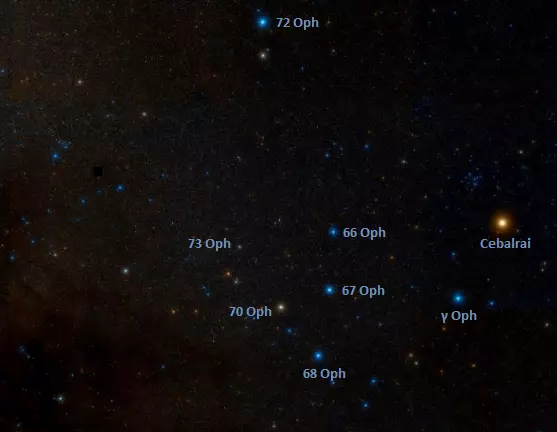
The Bull of Poniatowski, image: Wikisky
Three Patriarchs (Triangulum Australe)
In the far southern sky, the three bright stars that give the constellation Triangulum Australe its name are known as the Three Patriarchs. Easily found east of Alpha and Beta Centauri, the stars are Atria (Alpha Trianguli Australis), Beta, and Gamma Trianguli Australis. The 17th century German poet and author Philippus Caesius saw the stars as symbolizing Abraham, Isaac and Jacob, the Three Patriarchs. Atria, the brightest of the three (mag. 1.91), represents Abraham.
Autumn asterisms
The best-known asterisms in the autumn sky are those found in the constellations Cassiopeia, Pegasus, Perseus, Aquarius, and Pisces. Two prominent autumn asterisms – Cassiopeia’s W and the House of Cepheus – are circumpolar to northern observers. Autumn is the best time of year to observe them because they rise high above the horizon in the evening and make their way across the sky over the course of the night.
Cassiopeia’s W
Cassiopeia’s W (or the Queen’s W) is one of the most familiar patterns in the northern sky. Formed by Segin (Epsilon Cassiopeiae), Ruchbah (Delta Cassiopeiae), Gamma Cassiopeiae, Schedar (Alpha Cassiopeiae), and Caph (Beta Cassiopeiae), the W is visible throughout the year for northern observers. Depending on the time of year (or night), it may appear as an “M.”
Cassiopeia’s five brightest stars can be used to find the constellations in the vicinity. Cepheus appears on top of the W, and Perseus and Andromeda lie below it. The three constellations are linked by the Greek myth of the Queen Cassiopeia, whose husband Cepheus had to sacrifice their daughter Andromeda to the sea monster (Cetus) to appease the gods who were offended by the queen’s boastfulness.
Cassiopeia’s W is a guide to several bright, well-known deep sky objects and many fainter ones. The famous Heart and Soul Nebulae (IC 1805 and IC 1848) and the Double Cluster (NGC 884 and NGC 869) lie to the east of the W. The open cluster Messier 103 is in the same wide field of view as Ruchbah. The Pacman Nebula (NGC 281) appears just east of Schedar, and the bright open cluster Messier 52 and the Bubble Nebula (NGC 7635) lie on the line extended from Schedar to Caph to the northwest.
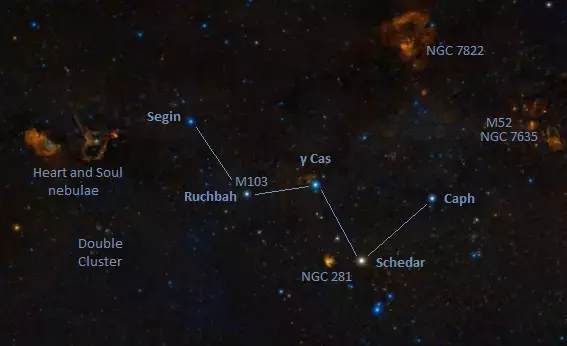
Cassiopeia field, image: Wikisky
House of Cepheus
The House pattern is the most prominent part of the constellation Cepheus. The brightest star in the asterism, Alderamin (Alpha Cephei), is found along the imaginary line drawn from Schedar through Caph (the stars on the right side of Cassiopeia’s W). Alderamin forms the base of the stick house with Zeta (or the fainter Delta) Cephei, and the rest of the house is outlined by Alfirk (Beta), Errai (Gamma Cephei), and Iota Cephei.
Cepheus is one of the northernmost constellations in the sky. It stays above the horizon throughout the year for northern observers. Alderamin, Alfirk, Errai and Iota Cephei all belong to a small group of stars that take their turn as the North Star over the course of Earth’s 25,770-year precession cycle. This means that they are largely unknown to southern observers; Cepheus is visible only north of the latitude 10° S.
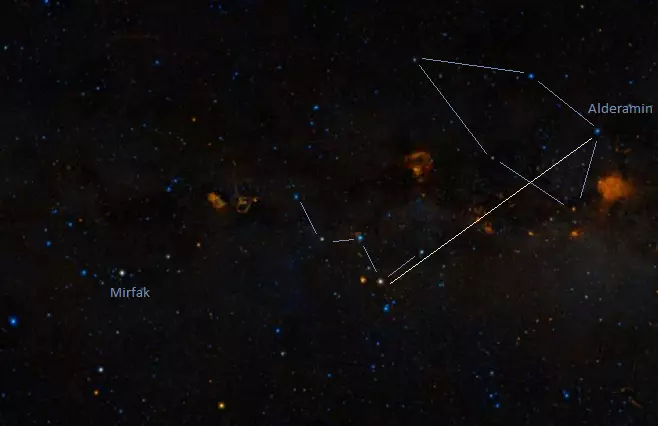
The House of Cepheus (right), Cassiopeia’s W (centre) and the Segment of Perseus (left), image: Wikisky
Segment of Perseus
The Segment is Perseus is an easily visible star pattern that curves across the constellation Perseus. Even though it is easy to see, there is no unified view on which stars form it. Some observers even include the Double Cluster (NGC 869 and NGC 884) in the asterism. The most prominent stars in the Segment are Miram (Eta Persei), Gamma Persei, Mirfak (Alpha Persei), Delta, Sigma, and Psi Persei. The Alpha Persei Cluster, an open cluster around Mirfak, appears as part of the pattern.
The Segment of Perseus is found along the imaginary line drawn from Gamma Cassiopeiae (the central star of the W) through Ruchbah (the bottom right star of the W). It curves across Perseus in the direction of the bright Capella in Auriga.
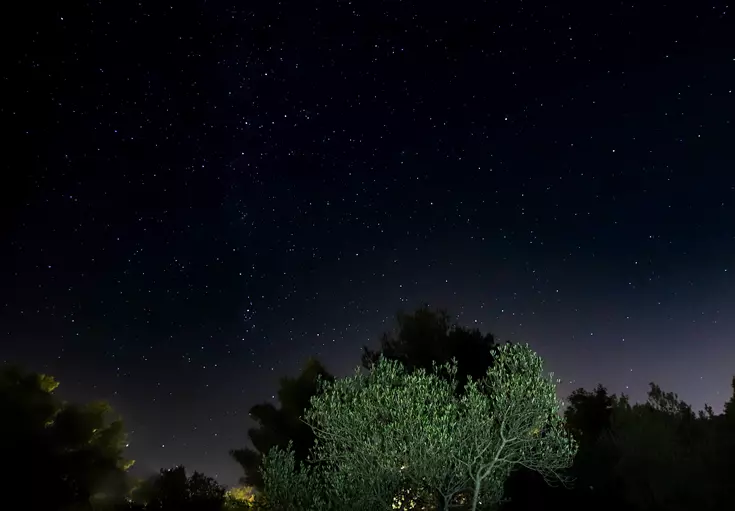
Cassiopeia’s W and the Segment of Perseus, image: Constellation Guide
Gorgon’s Head (Perseus)
The Gorgon’s Head (or Medusa’s Head) is an ancient asterism formed by the famous variable star Algol (Beta Persei), the second brightest star in Perseus, with the fainter Pi, Rho and Omega Persei. The three fainter stars were traditionally known as Gorgonea Secunda, Gorgonea Tertia and Gorgonea Quarta respectively, while Algol was Gorgonea Prima, in reference to the Gorgon sisters in Greek mythology. The stars 20, 16 and 12 Persei are sometimes included in the asterism.
In depictions of the constellation Perseus, Algol marks the head of the Medusa, the only mortal Gorgon. The four stars outline the head held by Perseus and were often depicted as a separate constellation – Caput Medusae (Medusa’s Head) – that was associated with Perseus.
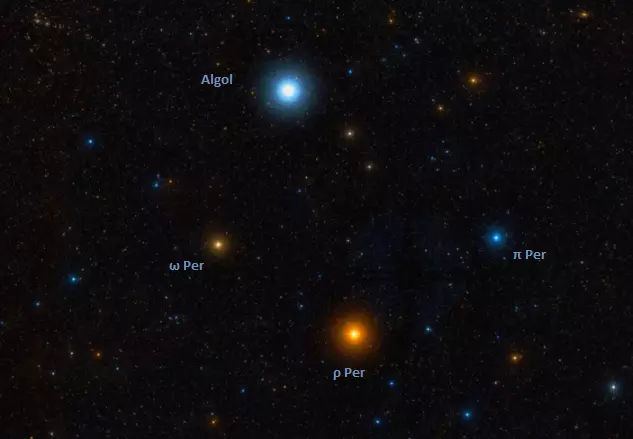
Medusa’s Head, image: Wikisky
Frederick’s Glory (Andromeda)
Frederick’s Glory is a Y-shaped asterism formed by Iota, Kappa, Lambda and Psi Andromedae. It lies north of the Great Square of Pegasus, roughly between Scheat, the top right star of the Great Square, and Schedar, the bottom right star of Cassiopeia’s W.
The asterism is the remnant of the obsolete constellation Honores Friderici (Gloria Frederici), created by the German astronomer Johann Elert Bode in 1787 to commemorate King Frederick the Great of Prussia after his passing. The constellation contained 76 stars that now lie in Andromeda, Lacerta, Cassiopeia, Cepheus, and Pegasus. Its brightest stars were Iota, Kappa, Lambda, Omicron, and Psi Andromedae.
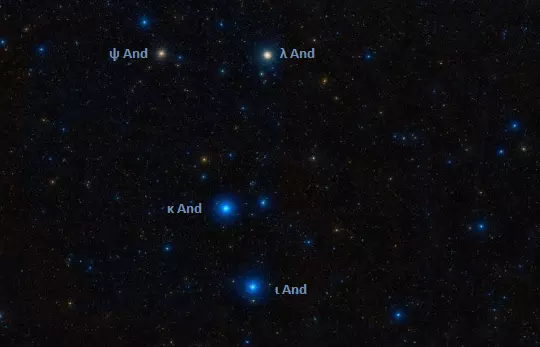
Frederick’s Glory, image: Wikisky
NGC 956 (Andromeda)
NGC 956 is an asterism discovered by the British astronomer John Herschel in December 1831. Herschel catalogued the object as an open cluster, but it is now known to be just a chance alignment of stars.
Triangulum
Triangulum is one of the constellations that was named for its main pattern. The elongated triangle that gives the constellation its name is found southwest of Algol in Perseus and south of Almach and Mirach in Andromeda. The three stars at its vertices are Beta Trianguli (mag. 3.00), Mothallah (Alpha Trianguli, mag. 3.42), and Gamma Trianguli (mag. 4.01). Together with Mirach, the stars can be used to locate the Triangulum Galaxy (Messier 33).
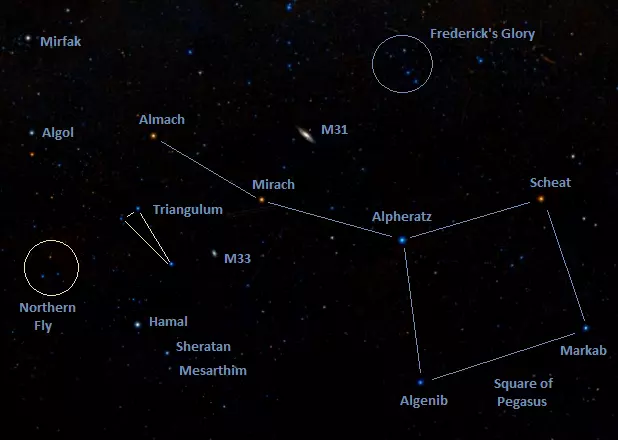
Triangulum and the Northern Fly, image: Wikisky
Collinder 21 (Triangulum)
Collinder 21 is another asterism catalogued as an open cluster. Located south of Mothallah, the star at the head of the Triangle, the asterism is formed by a group of unrelated stars that appear as a relatively bright cluster easily observed in small telescopes. It appears in the same area as several relatively bright galaxies, including NGC 684, NGC 672, IC 1727, and IC 1731.
Northern Fly (Aries)
The Northern Fly is a relatively faint asterism located in the constellation Aries. It is formed by 35, 39 and 41 Arietis, the main stars of the former constellation Musca Borealis (Northern Fly). The small constellation was created by the Dutch-Flemish astronomer Petrus Plancius in 1612. Plancius named it Apes (Bees) and included 33 Arietis.
In 1624, the German astronomer Jakob Bartsch renamed the constellation Vespa (the Wasp) and, in 1679, the French architect and cartographer Augustin Royer used the same stars to create a new constellation, Lilium (the Lily). Lilium represented the fleur-de-lis and was created in honour of King Louis XIV. Its name is remembered in the proper name of 39 Arietis, Lilii Borea (“in the north of Lilium”). Lilii Austrina (“in the south of Lilium”) was 41 Arietis, the brightest of the four stars, which is now formally known as Bharani.
The Great Square of Pegasus (Pegasus, Andromeda)
The Great Square of Pegasus is one of the most prominent asterisms in the northern autumn sky. It outlines the body of the celestial horse and connects the constellations Pegasus and Andromeda. The brightest star of the Great Square, Alpheratz (Alpha Andromedae) used to belong to both constellations, but is now assigned only to Andromeda. It marks Andromeda’s head. The other three stars that form the asterism are the Pegasus luminaries Scheat (Beta Pegasi), Markab (Alpha Pegasi), and Algenib (Gamma Pegasi).
The Great Square is commonly used to find the Andromeda Galaxy (Messier 31), Triangulum Galaxy (Messier 33), and the Great Pegasus Cluster (Messier 15). It can also be used to find several other asterisms. The Circlet of Pisces lies south of the line connecting Algenib and Markab, the Water Jar is found southwest of Markab, and the Lightning Bolt lies west of the star.
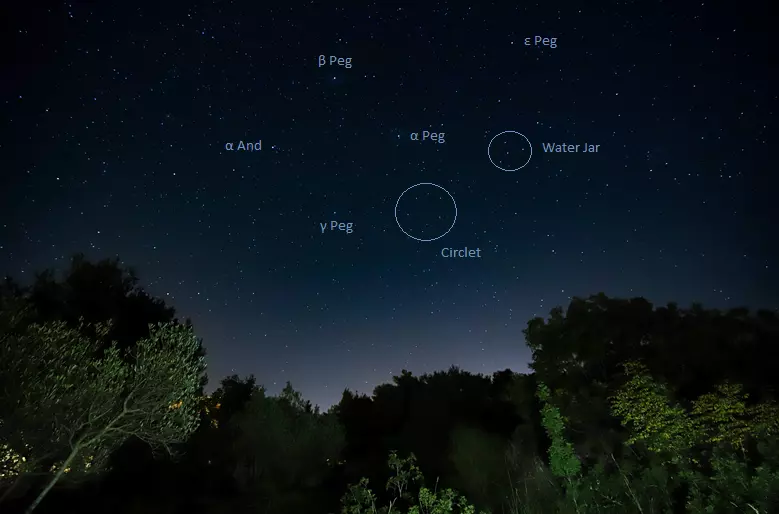
The Great Square of Pegasus, image: Constellation Guide
The Lightning Bolt (Pegasus, Aquarius, Capricornus)
The Lightning Bolt is a conspicuous asterism formed by the brightest stars in Pegasus, Aquarius, and Capricornus. The zig-zag pattern begins near the Square of Pegasus and passes close to the Water Jar in Aquarius. It can help identify the stars of the fainter Aquarius and Capricornus.
The Lightning Bolt is formed by Enif (Epsilon Pegasi), Sadalmelik (Alpha Aquarii), Sadalsuud (Beta Aquarii), and Deneb Algedi (Delta Capricorni). Enif, Sadalmelik and Sadalsuud are evolved luminous supergiant stars that are believed to have formed in the same stellar nursery. They lie more than 500 light years away. The white giant Deneb Algedi does not belong to the same family and is much closer to us at 38.7 light years. It marks the left tip of the relatively faint V-shaped pattern of the constellation Capricornus.
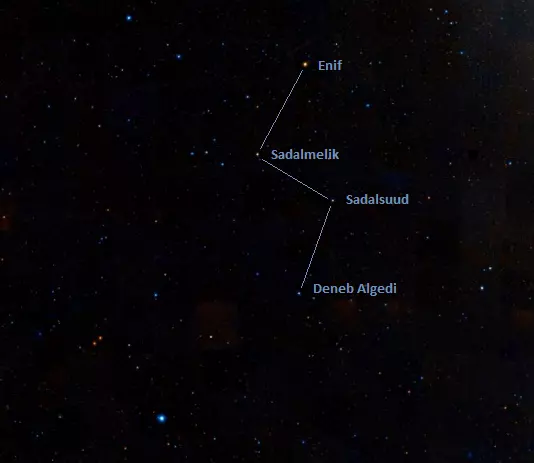
The Lightning Bolt, image: Wikisky
The Water Jar (Aquarius)
The Water Jar is the most recognizable part of Aquarius constellation. Also known as the Urn, the Y-shaped asterism represents the amphora from which the Water Bearer is pouring water in the direction of the mouth of the Southern Fish, marked by Fomalhaut.
The Water Jar is formed by Gamma, Pi, Eta, and Zeta Aquarii. It can be found south of the imaginary line connecting Markab in the Square of Pegasus and Enif, the brightest star in Pegasus.
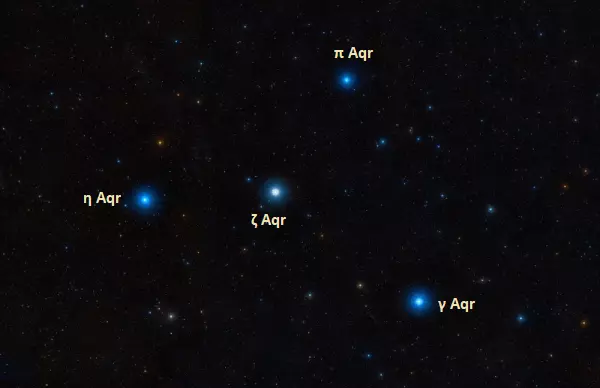
Water Jar stars, image: Wikisky
Messier 73 (Aquarius)
Messier 73 is a four-star asterism catalogued by Charles Messier as a cluster. It appears only several arcminutes east of the magnitude 9.35 globular cluster Messier 72. Both objects lie in the western part of Aquarius, just north of the main pattern of Capricornus.
M73 was once suspected to be an open cluster, but a 2002 study demonstrated that the stars did not share a common proper motion and were at very different distances from the Sun.
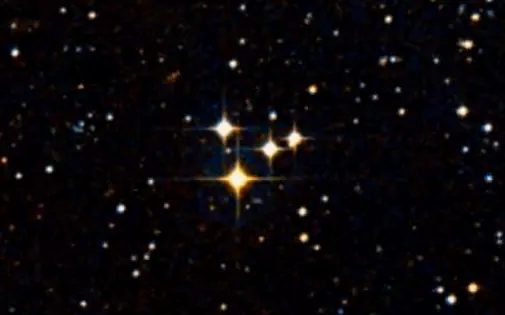
Messier 73, image: Wikisky
The Circlet of Pisces (Pisces)
The Circlet of Pisces is a faint but distinctive circle of stars that represents the head of the western fish in Pisces. The brightest stars in the asterism are Gamma, Iota, Theta, Lambda and Kappa Piscium. On a very clear night, the fainter 7 Piscium (b Psc) and 19 Piscium (TX Psc) complete the circle.
The Circlet lies south of the line connecting Algenib and Markab, the stars at the base of the Great Square of Pegasus.
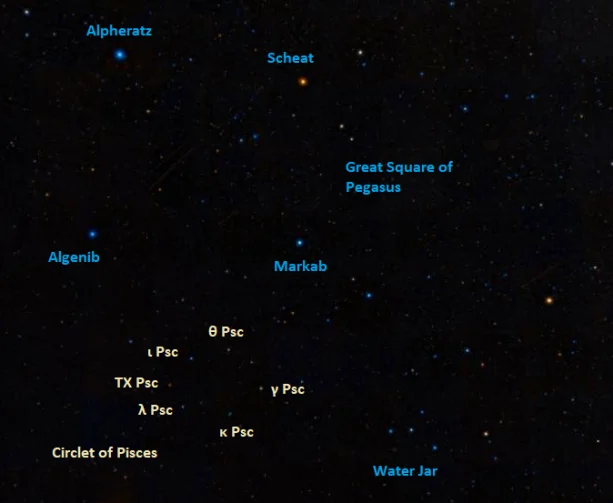
The Circlet of Pisces, the Great Square of Pegasus, and the Water Jar in Aquarius, image: Wikisky
Testudo (Pisces)
Testudo (the Turtle) is a faint asterism formed by 20, 24, 27, 29, 30 and 33 Piscium. The brightest of these stars, the red giants 30 and 33 Piscium, have apparent magnitudes of 4.37 and 4.61. The asterism lies between the Circlet of Pisces and Diphda (Beta Ceti), the brightest star in Cetus.
Testudo was one of the constellations proposed by the astronomer John Hill in 1754. Hill created it from the stars near the border with Cetus and Aquarius. The constellation was not widely accepted and soon became obsolete.
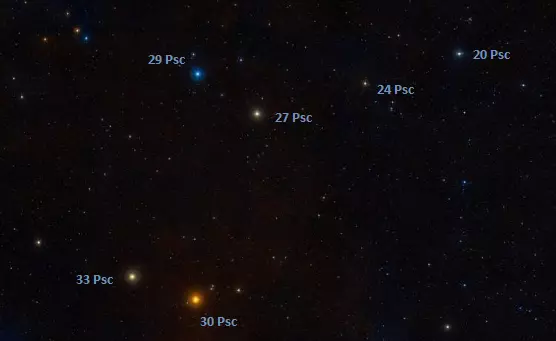
Testudo (the Turtle), image: Wikisky
Head of Cetus (Cetus)
The Head of Cetus, the Whale, is found using the V-shaped Hyades cluster as a pointer. The asterism is not very bright, but can be made out on a clear night. It is formed by Menkar (Alpha Ceti), Kaffaljidhma (Gamma Ceti), Lambda, Mu, Xi2, and Nu Ceti. Menkar, the brightest star in the asterism and second brightest in the constellation Cetus, marks the jaws of the Whale. It has an apparent magnitude of 2.53.
The Head of Cetus can be used to find the bright barred spiral galaxy Messier 77, which lies just south of Kaffaljidhma and east of Delta Ceti. Several fainter spiral galaxies lie in the same area: NGC 1055, NGC 1090, NGC 1073, and NGC 1087.
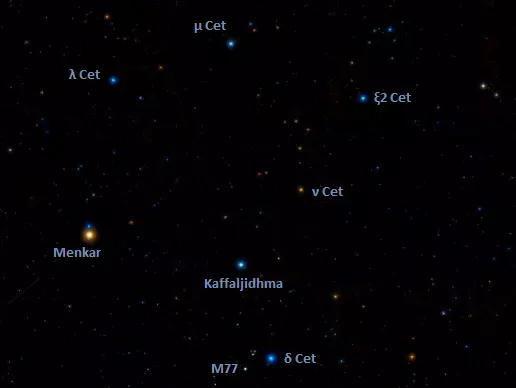
The Head of Cetus, image: Wikisky
Winter asterisms
The winter months provide a great opportunity to see the region of the sky around Orion and Canis Major, which contains more first-magnitude stars than any other area of the sky. Winter is the best time of year to see the asterisms in the constellations Orion, Taurus, Auriga, Camelopardalis, Monoceros, Vela and Carina.
Winter Hexagon
The Winter Hexagon is the brightest asterism in the sky. Also known as the Winter Circle, it is formed by six first-magnitude stars: Sirius in Canis Major, Procyon in Canis Minor, Pollux in Gemini, Capella in Auriga, Aldebaran in Taurus, and Rigel in Orion. From mid-northern latitudes, the asterism is visible in the evening sky throughout the winter months.
Finding the stars of the Winter Circle is easy. Orion’s Belt, one of the most recognizable features of the winter sky, points in the direction of Sirius to the southeast and Aldebaran to the northwest. Rigel marks Orion’s left foot (right from our perspective). Procyon is the brightest star east (left) of Betelgeuse, and Pollux is the slightly brighter of the two stars (the other being Castor) found on the imaginary line extended from Rigel through Betelgeuse. Capella, the northernmost of the six stars, is the brightest star in a smaller hexagon asterism that is part of the main pattern of Auriga, the Charioteer.
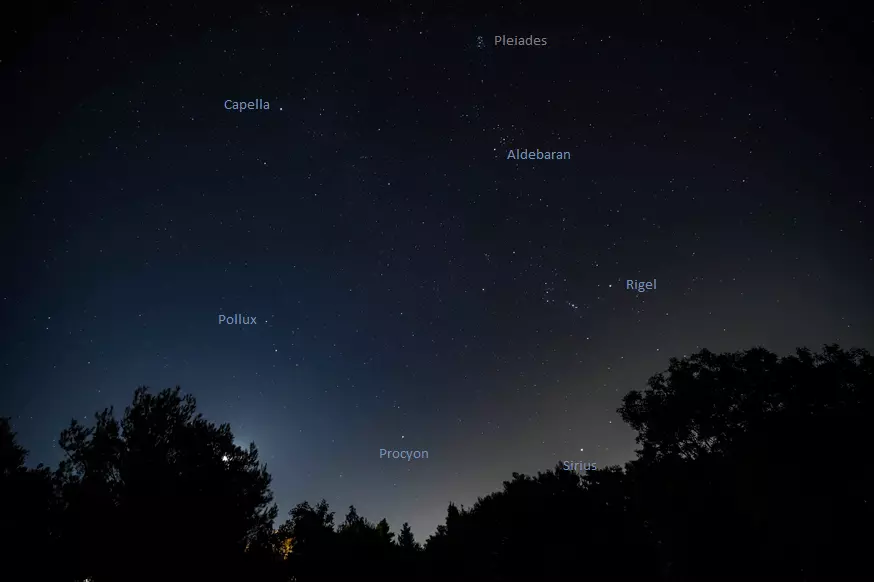
The Winter Hexagon, image: Constellation Guide
Heavenly G
The Heavenly G is a reimagined version of the Winter Hexagon. The bright Betelgeuse (Alpha Orionis) and Bellatrix (Gamma Orionis) at Orion’s shoulders complete the letter G formed by the Hexagon stars. Some observers also include Castor (Alpha Geminorum), while others exclude Bellatrix.
Winter Triangle
The Winter Triangle is found within the larger Winter Hexagon, with which it shares two stars: Sirius and Procyon. The third vertex is marked by Betelgeuse, which lies near the centre of the Winter Hexagon. Procyon and Betelgeuse can be used to find the Rosette Nebula, a vast star-forming region in Monoceros. The nebula appears roughly halfway between the two stars. Sirius and Procyon serve as guides for finding the bright open cluster Messier 50, which appears about two fifths of the way from Sirius to Procyon. Messier 41, another bright Messier open cluster, is found 4 degrees south of Sirius.
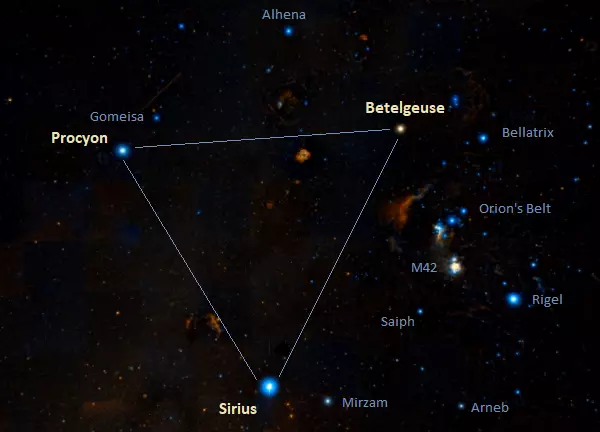
Winter Triangle, image: Wikisky
Egyptian X
The Egyptian X is formed by the stars of the Winter Triangle – Betelgeuse, Sirius and Procyon – with Naos (Zeta Puppis) and Phact (Alpha Columbae). Together, the five stars appear as two inverted triangles that meet at Sirius. They lie near the equator and the asterism is easier to see in its entirety from north Africa than it is from Europe, which is how it got its name.
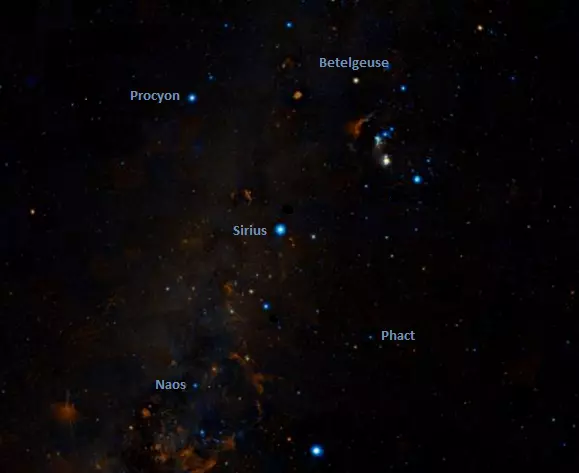
Egyptian X, image: Wikisky
Orion’s Belt (Orion)
Orion’s Belt is one of the best-known asterisms in the sky. Formed by the blue supergiants Alnitak (Zeta Orionis) and Alnilam (Epsilon Orionis) with the blue bright giant Mintaka (Delta Orions), the pattern of three stars in a row has been known to observers since prehistoric times. It is part of the larger hourglass pattern that defines the constellation Orion.
Orion’s Belt has been known by many other names in cultures across the world. The English names include the Three Kings, the Magi, Three Marys, Peter’s Staff, Jacob’s Rod, and the Yard-stick.
Alnitak, Alnilam and Mintaka are all exceptionally massive and luminous. Their energy outputs are 250,000, 537,000, and 190,000 times that of the Sun respectively. With masses 33, 40-44 and 24 times that of the Sun, the stars are set to end their lives as brilliant supernovae within the next few million years.
Alnilam, the central star of the Belt, is the most distant, lying approximately 2,000 light years away. Alnitak and Mintaka are physically closer to each other than to Alnilam. They lie about 1,200 light years from Earth.
Alnitak is a popular target for amateur astronomers because it appears near two bright nebulae: the emission nebula IC 434, which lies in the background of the famous dark Horsehead Nebula, and the Flame Nebula (NGC 2024), an emission nebula that appears just north of the star.
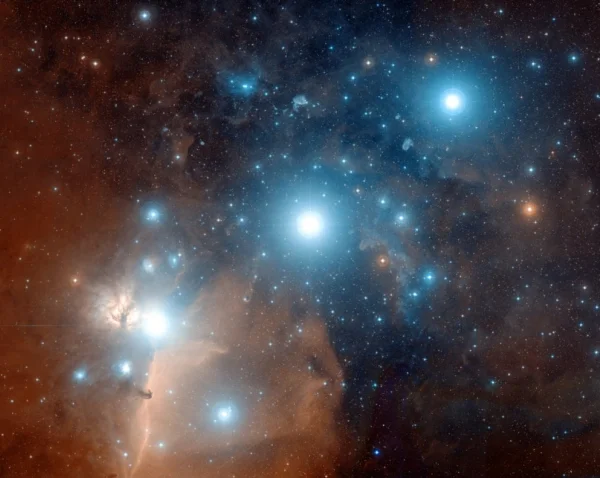
Orion’s Belt stars and the Flame Nebula, photo: Davide De Martin, Digitized Sky Survey, ESA, ESO, NASA FITS Liberator
Orion’s Sword (Orion)
Orion’s Sword is formed by three stars – 42 Orionis, Theta Orionis and Iota Orionis – and the Orion Nebula (Messier 42), one of the brightest star-forming nebulae in the sky.
42 Orionis is a luminous young B-type star surrounded by the large HII region designated Sharpless 279. Appearing only 0.6 degrees north of the brighter and larger Orion Nebula, Sharpless 279 hosts the reflection nebula known as the Running Man Nebula, a popular target for backyard telescopes.
Theta Orionis is a designation shared by multiple stars and star systems, all appearing in and within several arcminutes of the Orion Nebula. Theta1 Orionis is the designation used for the Trapezium Cluster, a young compact open cluster in the centre of the Orion Nebula, visible in small telescopes. Theta2 Orionis is also a multiple star system. It appears about 2 arcminutes away from the Trapezium Cluster.
Iota Orionis is the brightest point of light in Orion that is not part of the main hourglass asterism. It is a multiple star system composed of hot O- and B-type stars. It is a member of the young open cluster NGC 1980, nicknamed the Lost Jewel of Orion. The primary component in the Iota Orionis system is formally named Hatysa.
The Orion Nebula (Messier 42) appears as the central star of Orion’s Sword. With an apparent magnitude of 4.0, it is visible to the unaided eye even from areas with some light-pollution, and can be observed in binoculars and small telescopes. It lies approximately 1,344 light years away and stretches across an area of 65 by 60 arcminutes.
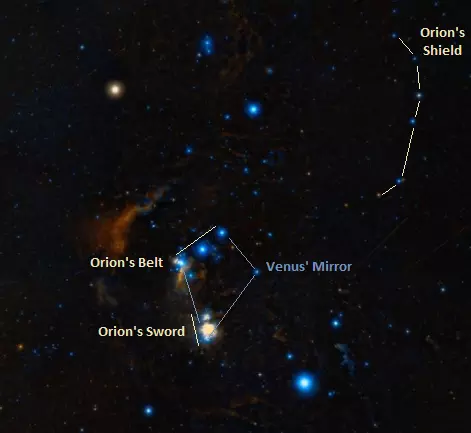
Orion’s Belt, Orion’s Sword, Orion’s Shield and Venus’ Mirror, image: Wikisky
Venus’ Mirror (Orion)
The four-sided pattern formed by the stars of Orion’s Belt and Orion’s Sword with Eta Orionis is called Venus’ Mirror (or the Saucepan). Like many other bright stars in Orion, Eta Orionis is a young, hot, massive blue star of the spectral type B. It lies just west of the imaginary line connecting Mintaka, the westernmost (right) star of Orion’s Belt, and Rigel at Orion’s foot.
Eta Orionis, the stars of Orion’s Belt and Sword (including the Orion Nebula), and many other bright stars in Orion are members of the Orion OB1 association. The stellar association includes several dozen massive, luminous blue stars of the spectral types O and B. The group is part of the Orion Molecular Cloud Complex, one of the most active nearby star-forming regions visible in the sky.
Orion’s Shield (Orion)
Orion’s Shield lies west (right) of Orion’s hourglass figure. Also known as Orion’s Bow, the asterism is formed by six stars and star systems that share the Bayer designation Pi Orionis. The stars are spread across almost 9 degrees in the sky. Some observers also include the two components of Omicron Orionis, which lie closer to Aldebaran.
The Pi Orionis stars lie at different distances from the Sun and are not physically related to one another. The brightest and nearest of these stars, Pi3 Orionis, is only 26.32 light years away and shines at magnitude 3.16. It is formally known as Tabit. The most distant of the six, the blue giants Pi4 and Pi5 Orionis, lie 1,050 and 1,300 light years away respectively.
37 Cluster (Orion)
NGC 2169, an open cluster in Orion, appears like the number 37 in the sky, which has earned it the nickname the 37 Cluster. The cluster is quite bright, with an apparent magnitude of 5.9, and lies 3,600 light years away. It can be found just below the bend of Orion’s arm, marked by Nu and Xi Orionis, north of Betelgeuse and less than halfway from Alhena in Gemini to Meissa, the star marking Orion’s head.
The cluster was discovered by William Herschel in October 1784. It consists of two open clusters, catalogued as Collinder 38 (mag. 8.4) and Collinder 83 (mag. 5.9).
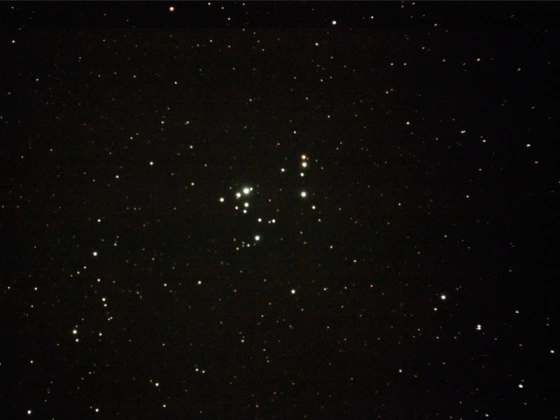
The 37 Cluster (NGC 2169), image: Wikimedia Commons/ScottRak (CC BY-SA 3.0)
NGC 1807 (Orion, Taurus)
NGC 1807 is an asterism catalogued as an open cluster in the New General Catalogue. It appears on the border between Orion and Taurus, about a third of the way from Aldebaran in Taurus to Alhena in Gemini. It stretches across 17 arcminutes and has an apparent magnitude of 7.86.
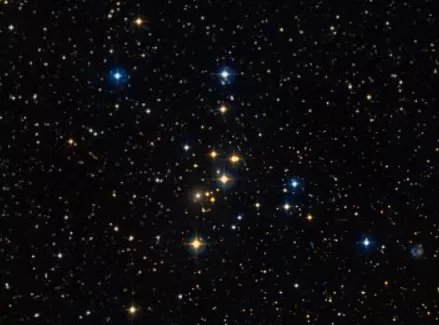
NGC 1807, image: Wikisky
Pakan’s 3 (Monoceros)
Pakan’s 3 is an asterism that looks like the number 3. It is found north of Sirius and west of the Seagull Nebula (IC 2177), about 2 degrees north of the magnitude 4.08 orange giant Theta Canis Majoris. It was discovered by Canadian amateur astronomer Randy Pakan.
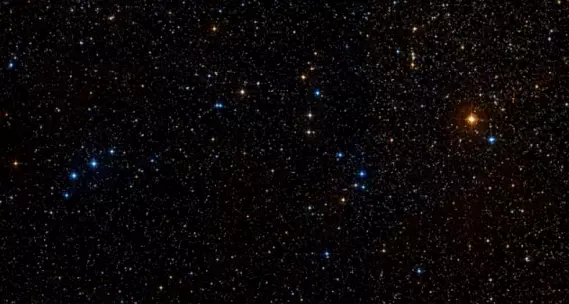
Pakan’s 3 in Monoceros, image: Wikisky
Christmas Tree Cluster (Monoceros)
The brightest stars of the open cluster NGC 2264 form a Christmas tree in the winter sky. While the cluster is technically not an asterism, it appears quite striking in binoculars and small telescopes at low power, which is why it is included on this list. It occupies 20 arcminutes of the apparent sky and has an apparent magnitude of 3.9. It can be found along an imaginary line extended from Bellatrix to Betelgeuse by a little more than the distance between the two stars. It appears in the same area of the sky as the Rosette Nebula, south of Alhena in Gemini and north of the line connecting Betelgeuse and Procyon.
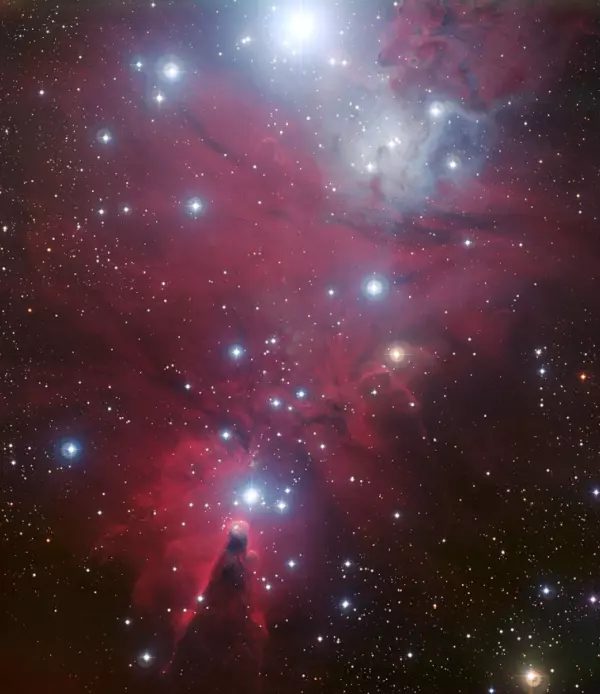
This colour image of the region known as NGC 2264 — an area of sky that includes the sparkling blue baubles of the Christmas Tree star cluster — was created from data taken through four different filters (B, V, R and H-alpha) with the Wide Field Imager at ESO’s La Silla Observatory, 2400 m high in the Atacama Desert of Chile in the foothills of the Andes. The image shows a region of space about 30 light-years across. Image: ESO
Throne of Jawza (Lepus)
The Throne of Jawza is formed by Arneb (Alpha Leporis), Nihal (Beta Leporis), Gamma and Delta Leporis. The constellation Lepus (the Hare) is found just under Orion’s feet and its brightest stars – the supergiant Arneb and bright giant Nihal – are easily visible with apparent magnitudes of 2.589 and 2.84. Gamma and Delta Leporis are fainter and lie east of the brighter pair, in the direction of Sirius. In Arabic astronomy, the asterism was also known as Camels Quenching Their Thirst.
Jawza is the old Arabic name for the constellation Orion. Loosely translated as “the central one,” the name referred to a female figure in old Arabian legend, but its exact origin is uncertain. The name of Alpha Orionis, Betelgeuse, is derived from it.
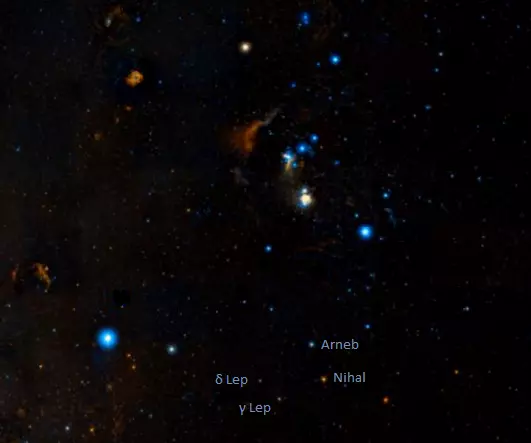
Throne of Jawza in Lepus, image: Wikisky
Auriga’s hexagon (Auriga, Taurus)
Auriga’s hexagon is the most prominent part of the Charioteer’s main constellation figure. It is formed by Capella (Alpha Aurigae), Menkalinan (Beta Aurigae), Mahasim (Theta Aurigae), Almaaz (Epsilon Aurigae), Hassaleh (Iota Aurigae), and Elnath (Beta Tauri). Historically, Elnath belonged to both Taurus and Auriga. Now it is assigned only to Taurus and marks the Bull’s northern horn.
Capella, the brightest star in the asterism, is the sixth brightest star in the sky and the third brightest star in the northern celestial hemisphere. Also known as the Goat Star, it represents the goat held by the celestial Charioteer. The goat’s kids are represented by Eta and Zeta Aurigae, the two brightest stars within the hexagon, near Capella.
Auriga’s hexagon can be used to find several bright deep sky objects. The open clusters Messier 36 and Messier 38 and the emission and reflection nebula IC 405 (the Flaming Star Nebula) appear in the area between Mahasim and Hassaleh. The open cluster Messier 37 is found just outside the hexagon, near the line connecting Mahasim and Elnath.
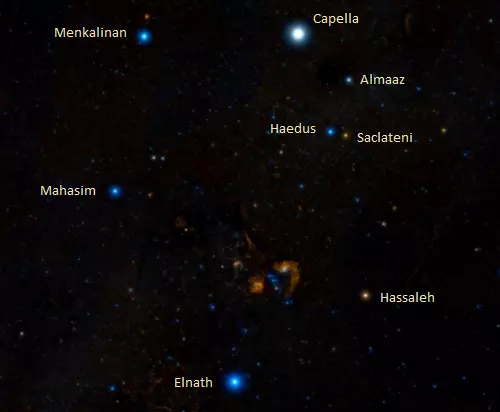
Auriga’s hexagon and the Kids (Haedi), image: Wikisky
The Kids (Auriga)
Eta and Zeta Aurigae have been known as the Kids (or Haedi) since ancient times. The blue Eta and orange Zeta are found within the large hexagon that makes the constellation Auriga instantly recognizable. They are slightly fainter than the stars of the hexagon.
Eta and Zeta Aurigae represent the two kids of the she-goat represented by the bright Capella. In Greek mythology, Capella is associated with Amalthea, the goat that nursed the infant Zeus, whose broken horn became the cornucopia, the horn of plenty. The Kids stars were traditionally known as Haedus I (Zeta Aurigae) and Haedus II (Eta Aurigae). When the International Astronomical Union (IAU) set out to standardize the proper names of stars, Eta Aurigae was given the name Haedus (the Kid), and Zeta Aurigae was formally named Saclateni. The name Saclateni is a misspelling of Sadatoni, which is derived from the Arabic as-sācid aθ-θānī, meaning “the second arm.”
Some observers include Almaaz (Epsilon Aurigae) as one of the Kids, but the star has traditionally marked the Charioteer’s left elbow and is part of the larger hexagon asterism. In Greek lore, Amalthea and her two kids (not three) were placed in the sky by Zeus as a sign of gratitude.
Cheshire Cat/Smiley Face (Auriga)
The Cheshire Cat is an asterism that observers usually come across when looking for the Starfish Cluster (Messier 38). Located roughly halfway between Mahasim and Hassaleh, the bright open cluster appears on the cat’s cheek. The smaller open cluster NGC 1907 appears closer to the centre of the face. The patch of nebulosity along the “smile” is the emission nebula IC 417, and the smaller nebula to the southeast is NGC 1931. Together, IC 417 and NGC 1931 have been nicknamed the Spider and the Fly.
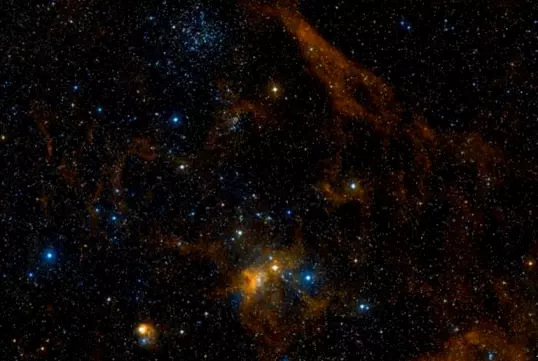
The Cheshire Cat (Smiley Face) in Auriga, image: Wikisky
Asses and the Manger (Cancer)
The stars Gamma and Delta Cancri form an ancient asterism known as the Asses and the Manger with the bright Beehive Cluster (Messier 44). The Greeks knew the two stars as Ὄνοι (Onoi), meaning “asses,” and M44 represented a manger from which the donkeys were eating. In Greek mythology, the stars were associated with the donkeys on which the god Dionysus and his companion Silenus rode into battle against the Titans.
The stars’ official names are a reference to this legend. Gamma Cancri is formally known as Asellus Borealis (“the northern donkey”) and Delta Cancri is Asellus Australis (“the southern donkey”). Messier 44 is also known as Praesepe, which is Latin for “manger.”
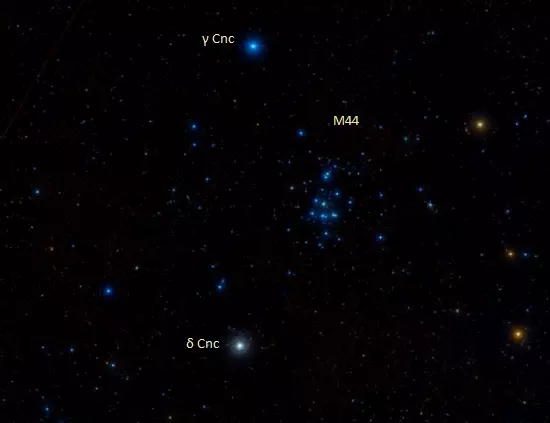
Asses and the Manger, image: Wikisky
Kemble’s Cascade (Camelopardalis)
Kemble’s Cascade (Kemble 1) is an asterism that appears as a straight line of stars spanning about 3 degrees in the far northern sky. The line ends with the magnitude 6.9 open cluster NGC 1502, also known as the Jolly Roger Cluster. More than 20 stars form the Cascade, the brightest of which, HD 24479, shines at magnitude 4.95.
Kemble’s Cascade was named after Father Lucian Kemble, a Franciscan friar who wrote about the asterism to Sky and Telescope columnist Walter Scott Houston. Houston named the pattern in his honour.
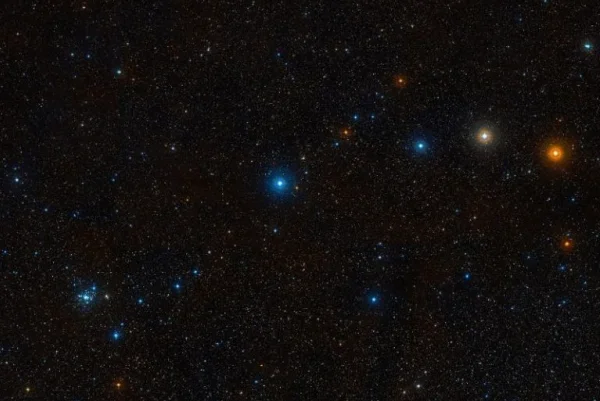
Kemble’s Cascade (Kemble 1), image: Wikisky
Golden Gate of the Ecliptic (Taurus)
The Golden Gate of the Ecliptic is an asterism formed by two exceptionally bright open clusters in Taurus: the Pleiades and the Hyades. The clusters appear as posts of a gate through which the ecliptic (the Sun’s apparent path across the sky) passes. The Sun, Moon and planets regularly pass through the gate. The asterism has been known for thousands of years.
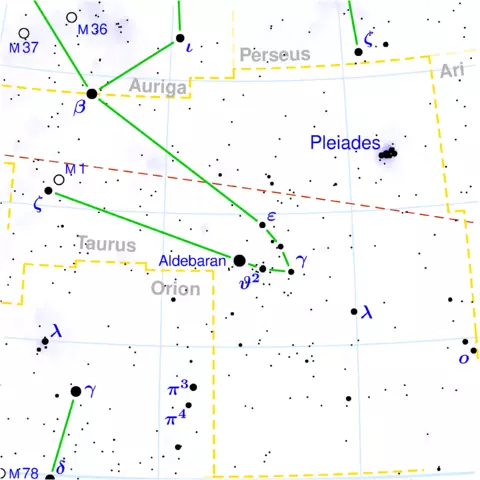
The Golden Gate of the Ecliptic, image: Torsten Bronger
The Bull’s Head (Taurus)
The Bull’s Head, or the V, is formed by five giant stars. These are Aldebaran, the brightest star in Taurus, and the four brightest members of the Hyades cluster: Gamma, Delta, Epsilon, and Theta Tauri. The Hyades stars are formally named Prima Hyadum (Gamma Tauri A), Secunda Hyadum (Delta1 Tauri A), Ain (Epsilon Tauri), and Chamukuy (Theta Tauri Aa). As the Bayer designations suggest, most of these stars are components in multiple star systems.
The fainter stars of the cluster complete the V-shaped outline of the Bull’s Head. Aldebaran and Ain (Arabic for “eye”) mark the Bull’s eyes and Prima Hyadum (the First Hyad) marks the tip of the V.
The Hyades cluster is very easy to find because, with an apparent magnitude of 0.5, it is visible to the unaided eye even from light-polluted areas. Aldebaran, the 14th brightest star in the sky, appears in the same line of sight as the cluster, but is not physically related to it. The cluster lies 153 light years away and Aldebaran is much closer to us at 65.3 light years. Aldebaran and the Hyades can be found using the three bright stars of Orion’s Belt, which point in the direction of the cluster.
The Bull’s Head makes it easy to identify other bright stars in Taurus. These include Elnath (Beta Tauri), which is part of Auriga’s hexagon and marks the Bull’s northern horn, Tianguan (Zeta Tauri) at the southern horn (near the famous Crab Nebula), and Lambda Tauri at the Bull’s chest. The Pleiades, which are easier to spot than the V, rest on the Bull’s shoulder.
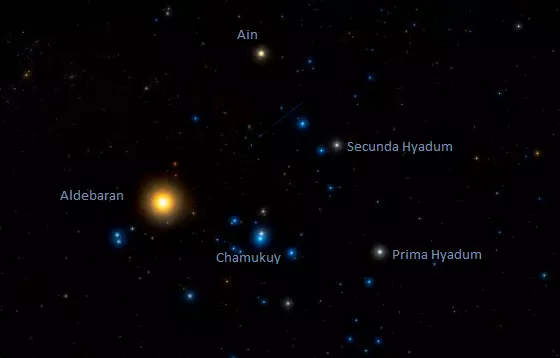
The Bull’s Head, image: Wikisky
NGC 1746 (Taurus)
NGC 1746 is an asterism catalogued as an open cluster in the New General Catalogue. The object was discovered by the German astronomer Heinrich Louis d’Arrest in 1863. The chance alignment of stars stretches across about 40 arcminutes and has an apparent magnitude of 6.1. It lies in the area between Aldebaran and Elnath.
False Cross (Vela, Carina)
The False Cross is formed by four bright stars in Carina and Vela. In the order of brightness, they are: Avior (Epsilon Carinae), Alsephina (Delta Velorum), Aspidiske (Iota Carinae), and Markeb (Kappa Velorum). Alsephina is the nearest of the four stars at 80.6 light years. The supergiant Aspidiske and giant Avior are the most distant at 690 and 610 light years. Markeb, a blue subgiant, lies approximately 570 light years away.
The False Cross is one of the three diamond-shaped “cross” asterisms in the far southern sky, along with the Southern Cross in Crux and Diamond Cross in Carina. It is called the False Cross because it is often mistaken for the Southern Cross, which is used to find the south celestial pole. The False Cross is larger and fainter than the Southern Cross, but brighter than the Diamond Cross, which lies in the area between the other two asterisms. The False Cross appears the closest to Canopus, the second brightest star in the sky, the Southern Cross is in the same area as Alpha and Beta Centauri, while the Diamond Cross does not appear near any first-magnitude stars.
The three asterisms are largely unknown to observers in the northern hemisphere, but can be seen from northern locations close to the equator at certain times of year. Avior, the southernmost star of the False Cross, has the declination −59° 30′, making the asterism theoretically visible south of the latitude 30° N. However, the stars never rise very high above the horizon for northern observers. The best time of year to see the constellations Carina and Vela is during the northern hemisphere winter.
The False Cross is known for causing errors in celestial navigation, but it will not stay false forever. In the 80th and 90th centuries, the south celestial pole will travel through it, passing near Aspidiske and Alsephina.
The False Cross can be used to find the Southern Beehive Cluster (NGC 2516), which appears southwest of Avior, and the Omicron Velorum Cluster (IC 2391), located north of Alsephina. The bright globular cluster NGC 2808 appears on the imaginary line extended from Markeb through Aspidiske.
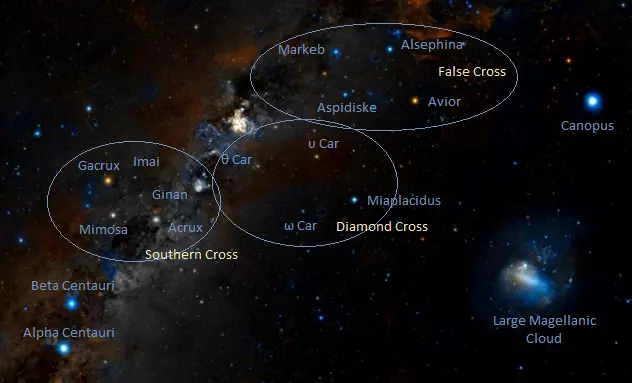
The Southern Cross in Crux, the Diamond Cross in Carina, and the False Cross in Carina and Vela, image: Wikisky
Diamond Cross (Carina)
The Diamond Cross is less conspicuous than its two neighbours. It is formed by four bright stars in Carina: Miaplacidus (Beta Carinae), Theta, Upsilon, and Omega Carinae. The southernmost of the four, the blue giant Omega Carinae, has the declination -70° and never rises above the horizon for most northern observers. Depending on the geography, it can be visible from locations south of the latitude 20° N.
Miaplacidus, the brightest star of the Diamond Cross, has an apparent magnitude of 1.69. It is the second brightest star in Carina, after Canopus. It lies 113.2 light years away and is the nearest of the four stars to Earth. The supergiant Upsilon Carinae, the most distant of the four, lies approximately 1,400 light years away.
The Diamond Cross can be used to find several bright deep sky objects. Theta Carinae is the brightest member of the Theta Carinae Cluster, a magnitude 1.9 open cluster located 547 light years away. Nicknamed the Southern Pleiades, the cluster is visible without binoculars. The famous Carina Nebula lies north of Theta Carinae. Mostly unknown to northern observers, the nebula is easily visible to the unaided eye, with an apparent magnitude of 1.0. With an apparent size of 120 arcminutes, it appears four times larger and considerably brighter than the Orion Nebula. However, with a declination of about -60°, it never rises for observers north of the latitude 30°N.